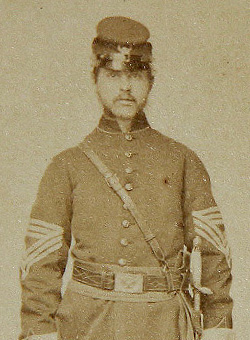
Please send all Checks and Money orders to :
Dave Taylor P.O. Box 87 Sylvania, OH 43560
419-842-1863
Click Here to E-mail Us!
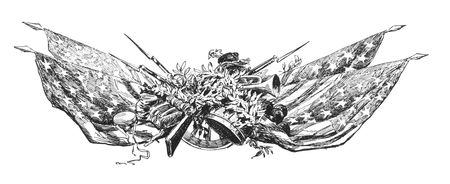

15 09 second list
LAYAWAYS ARE WELCOME:
Need to split your order into multiple payments? No problem! A simple 20% earnest money deposit will hold your item for you.
You can then pay it off in easy installments that fit your budget.
Read Terms Here
~~~~~~~~~~

15-09-01 … Super Tagged Spanish American War Battle Relic – Battle of Santiago Harbor …
This relic door knob was part of the historical museum of Captain Charles Roberts 124th Penna. In July of this year Morphy Auctions sold all of the Roberts family artifacts. I obtained a few interesting tagged relics, of which this is one. It is a brass door knob with brown ink tag that reads
”
Door Knob of Captain’s Cabin on Sunken Spanish War Ship Viscaya in Santiago Harbor 1898″
A quick check of our instant educator Wikipedia relates the following intersting background on the
Viscaya
“Vizcaya
was built at Bilbao, Spain. She was laid down in 1889, launched on 8 July 1891, and completed in 1893.
She had two funnels and was fast and well armed … Her armor was poor: her 11-inch guns had only lightly armored hoods, her 5.5-inch guns were mounted in the open on the upper deck, her armor belt was thin and protected only two-thirds of her length, and she had a high, unprotected freeboard that took much damage during the
Battle of Santiago de Cuba.
Like other nineteenth-century warships, she was heavily furnished and decorated with wood, which the Spanish failed to remove prior to combat and which would feed fires during the battle.
“… At about 0845 hours on 3 July 1898, the Spanish ships got underway. The U.S. squadron sighted the Spanish ships in the channel at about 0935, and the
Battle of Santiago de Cuba
began …By 1050,
Vizcaya
and
Cristóbal Colón
were the only Spanish ships left.
USS Brooklyn
now focused on
Vizcaya
, closing to a range of 950 yards and pounding
Vizcaya
with numerous 8-inch and 5-inch shell hits, while battleships
Texas
Iowa
Oregon
, and
Indiana
also scored hits.
Vizcaya
managed to score two 5.5-inch hits on ;
Brooklyn
, killing the lone American sailor who died in the battle. But at about 1100,
Brooklyn
scored two punishing 8-inch hits on
Vizcaya
; one detonated a torpedo in her forward tube and blew a large part of her bow off, and the other knocked down her bridge and set her decorative woodwork and wooden furnishings on fire. When the fire began to cause ready ammunition for the secondary battery to explode, the end was clearly at hand for
Vizcaya
. At 1106, she turned toward the shore, struck her battle ensign, and ran herself up on the beach.
Some of her sailors made it ashore, although they had to beware of Cuban insurgents, who began to shoot the survivors of the wrecked Spanish ships. Others were rescued by American sailors who brought small boats alongside the wrecks to take off survivors. One of those rescued was the commanding officer of
Vizcaya
, Captain Don
Antonio Eulate
, who, when brought aboard
Iowa
, looked at the burning wreck of his ship, raised his hand in salute, and called out ”
Adios, Vizcaya!
” Immediately, as if on cue, the cruiser’s forward magazines exploded…”
That’s a damn fine tale.
A lot of history behind a neat little brass relic
… noco
… $275.00 – SOLD
Click Here to E-mail Us!
Call us @ 419-842-1863
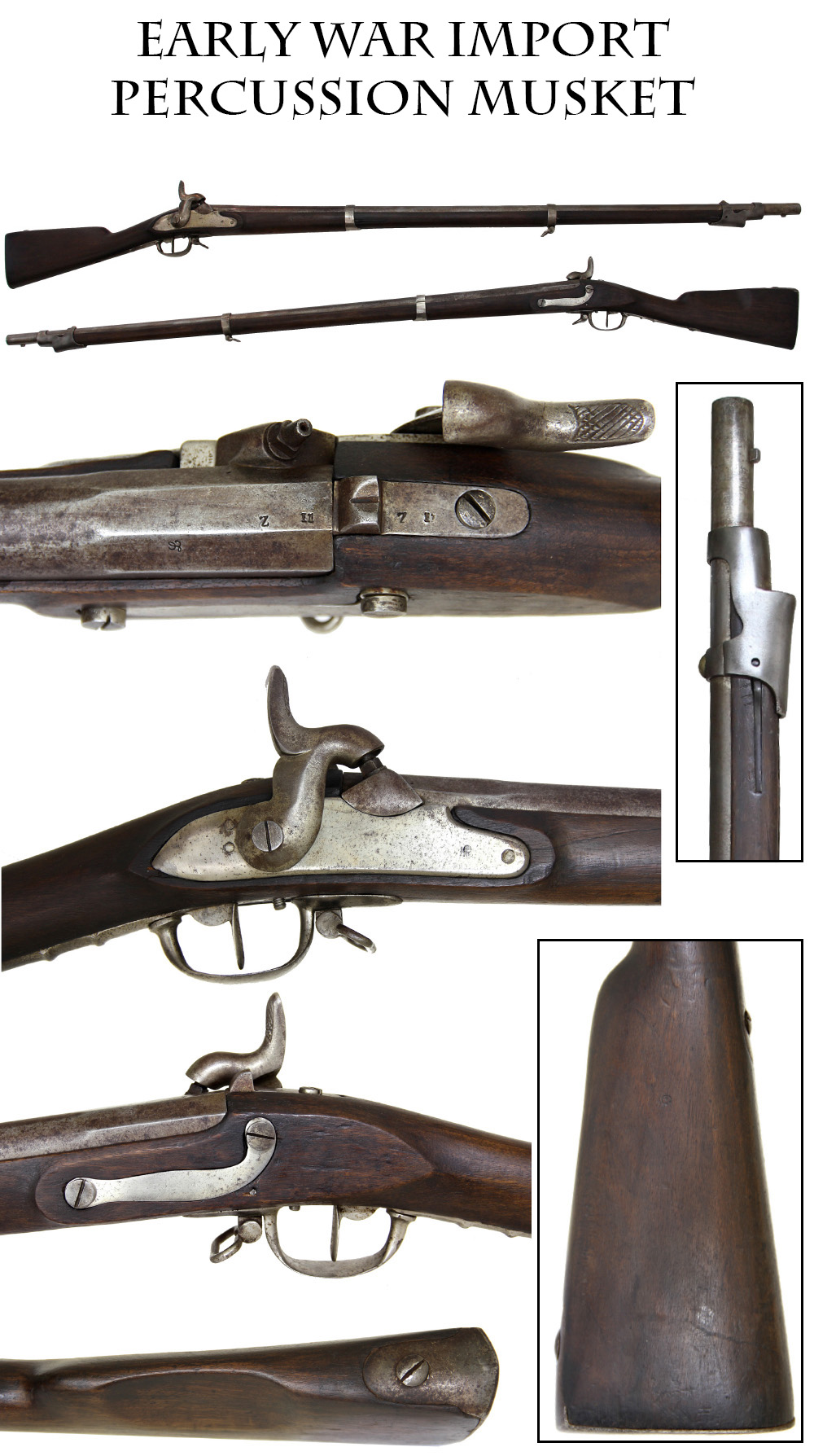
15-09-02 … Early War Import Percussion Musket / Swiss? …
An unmarked infantry musket of about .70 caliber, likely Swiss based on the hammer style. If not Swiss, then one of the German states, typical of those brought into North America for both Union and Confederate armies early in the Civil War. 57 inches overall, barrel 42 inches. Hollowed cheek rest in the butt, a number of small letter and number inspection or maker stamps. Script “L” on the top of the barrel. Simple fixed rear sight and front sight mounted on the forward barrel band, bottom mounted bayonet stud. Bands and swivels in place, but no ramrod. Mechanically excellent. Overall about “fine” condition. Smooth dark wood stock with good edges. Metal in the bright with scattered gray and brown age spotting. A very affordable and very displayable Civil War percussion musket … cej-mil
… $695.00 – SOLD
Click Here to E-mail Us!
Call us @ 419-842-1863

15-09-03 … William Mason Contract 1861 Springfield Pattern Rifle Musket …
William Mason of Taunton, Mass., was a prolific inventor who amassed more than 50 patents during his career. He was given a contract in January, 1862, for 50,000 arms with an option to supply another 50,000 if he could manufacture them within the same time frame. The contract was subsequently modified to 30,000 arms. This one has sharp “US/ Wm. Mason/ Taunton” markings on the lock plate forward of the hammer and an 1863 date aft. The eagle under the nipple is a bit light and shows some corrosion from the percussion caps. Very legible V/P/eagle barrel proofs and clear wood cartouche on the offside. Both sights and all bands, springs, swivels and rod in place. Good mechanics. Slightly rounded edges to the lock apron from legitimate use. Pleasing warm brown tone to the wood. Metal generally smooth silver gray with some age spotting, and areas of moderate pitting near the breech which obscures the barrel date. Good bore. A nice, straight 1861 contract rifle musket with a good mid-war date … fjj-mil
… $1,150.00 – SOLD
Click Here to E-mail Us!
Call us @ 419-842-1863

15-09-04 … Very Displayable and Artistically Painted 58th Massachusetts Officer’s Small Size Camp Trunk and Many Papers …
These small traveling trunks were very typical of what officers actually took with them to the front. Small and very displayable, measures about 10″ by 14″ by 24″, leather covered over sturdy wood, with wood and metal edge and corner reinforcements. These often show up in period camp photos. This one has a great, dead real, identification painted on one end: “Lt. L.D. Monroe / 58th Mass. Vol.” This is Lorenzo Dow Monroe, who saw service first in the Massachusetts First Battalion of Heavy Artillery as a private, enlisting and mustering in 3/4/62 into Co. A. He reenlisted as a veteran on 3/25/64 and was discharged for promotion 4/13/64, taking a commission dated 4/21/64 as 2nd Lieutenant of Co. I, 58th Mass. He made 1st Lt/. on 8/8/64. He was taken prisoner at Poplar Grove Church, Va., south of Petersburg, in September, and was eventually paroled on 2/22/65. He mustered out 7/14/65. After the war he was active in the GAR, serving as Post Commander of the F.W. Pierce Post 8 in Middleborough, Mass.
The 58th Mass recruited in early 1864 and served in the 9th Corps during the period of Grant’s overland campaign. It lost 10 officers and 129 enlisted men killed or mortally wounded included 7 killed and 23 wounded at the Wilderness, 13 killed and 90 wounded at Spottsylvania, and others at Bethesda Church, and Petersburg, including the Battle of the Crater. At Poplar Grove Church the regiment lost 2 killed, 10 wounded and 99 captured, among them Lt. Monroe. In April, 1865, after Monroe returned to the regiment, it took part in the assault on Fort Mahone.
Monroe’s name is both painted on one end of the trunk and penned on a paper label. It’s a very livable size for a collector, not big and bulky like so many trunks. This one displays nicely on a counter top or display shelf. The contents include Monroe’s discharge from his first service, his commission from the Governor as First Lieutenant in the 58th, a GAR reunion ribbon, five 1865 manuscript letters (this shows that he was back with his regiment in the field after his release as a POW), three envelopes, two clothing returns, one muster roll, one final statement, one treasury dept return and envelope, and two post war tax receipts. We found a photo of Monroe attached to his listing on CWData, which we show here. A wonderful identified grouping with super eye appeal and great display potential. … djj
… $950.00 – SOLD
Click Here to E-mail Us!
Call us @ 419-842-1863

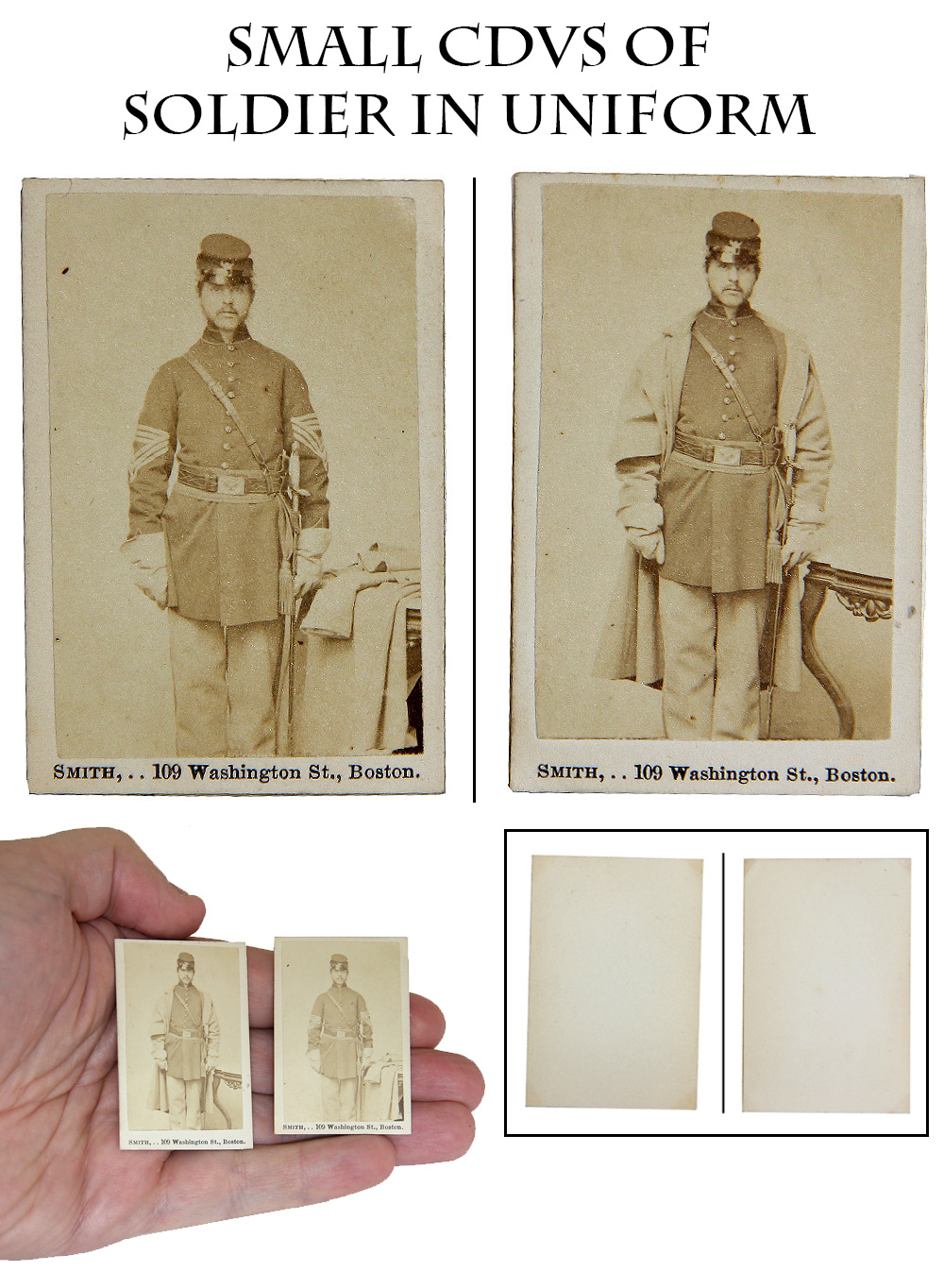
15-09-05 … Two Mini CDVs of a Massachusetts Regimental Quartermaster Sergeant …
These two carte-de-visites by Smith of Boston are very unusual in size, measuring only 1 by 2 inches. They are the first such mini-cartes I have encountered in my many decades of collecting and dealing, which is the main reason I bought them. They have excellent clarity and portray the same man at the same photography session in slightly different poses. In both he wears a very cool McDowell style forage cap with sloping visor just showing part of a hunting horn with a single digit numeral in its loop. He wears a regulation enlisted frock coat with large quartermaster sergeant chevrons and gauntlets. Buckled around his waist is an officer’s style sword belt with its fancy stitching showing and with a shoulder belt as well, fastened of his NCO sash, which he wears as part of the regimental noncommissioned staff. At his side he carries an NCO sword suspended by a frog from his waist belt, the sword apparently of the 1840 non-regulation militia pattern with a bone grip. In one photo he wears his overcoat as well, in the other photo he has placed it over a table at his side. A nice shot of a regulation uniform with some non-regulation touches. Regimental Quartermaster Sergeants operated under the Regimental Quartermaster and supervised the reception and distribution of equipment and supplies, other than food. He was also in charge of the regimental supply wagons and teamsters. It was regarded as a position of great responsibility and required someone of great honesty who combined the talents of a bookkeeper with the forcefulness of a labor foreman. An interesting photographic format and two nice images. With a little work it might be possible to identify him. For the pair … ge
… $185.00 – SOLD
Click Here to E-mail Us!
Call us @ 419-842-1863
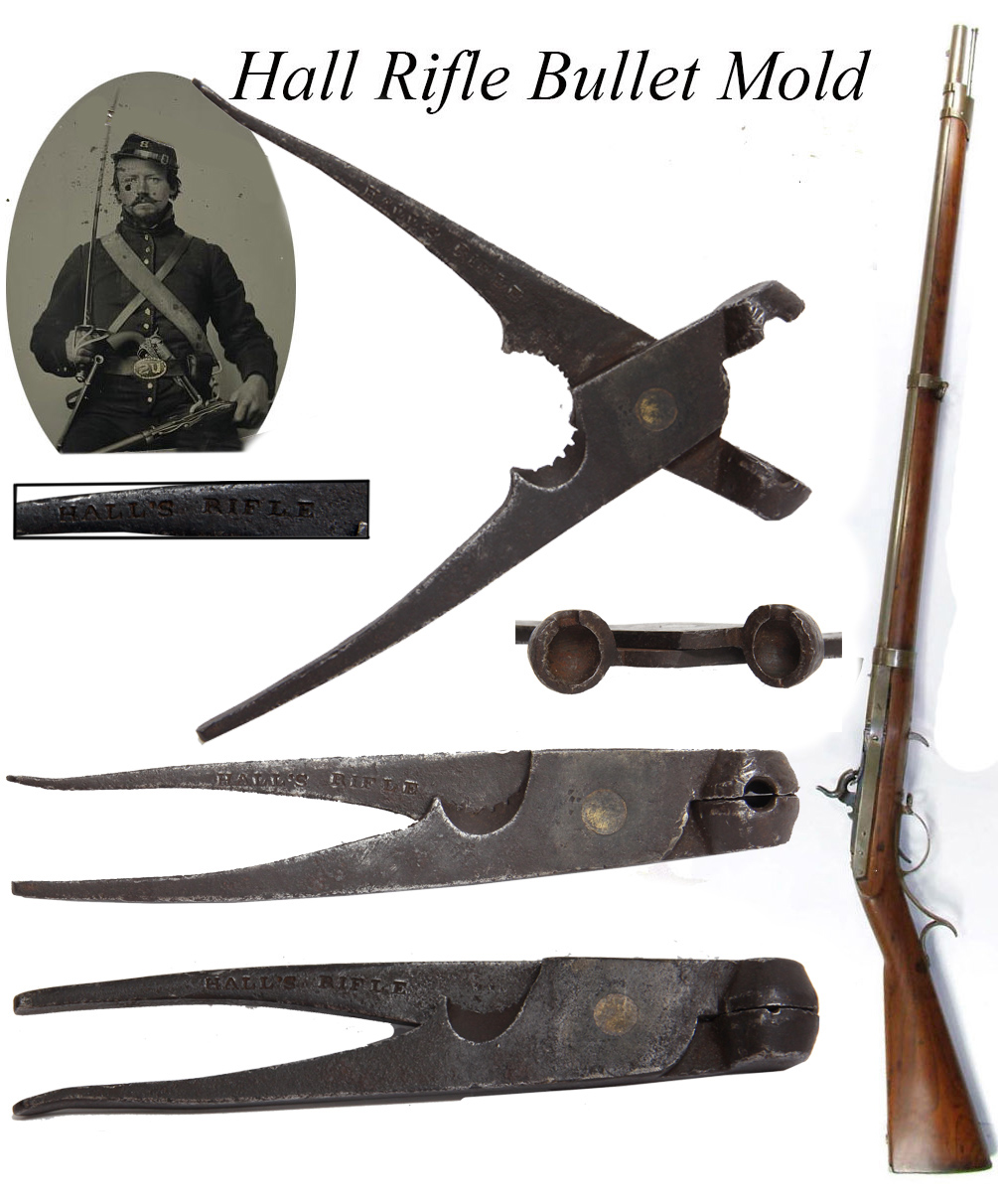
15-09-06 … Two Original Bullet Molds For “Hall’s Rifle” and so marked …
An extremely scarce piece of early American militaria are these single cavity, round ball, 52. caliber steel bullet molds which were made at the Harpers Ferry Arsenal. You will look long and hard to find one of these “sleeping” at a gun show or auction. I got these two out of an ancient collection of Hall guns and related. Both are fully functional with decent cavities. The top mold shown as number 1 is pitted along the handles. The “Hall’s Rifle” marking is visible but mixed with pitting. The bottom mold shown as number 2 is substantially better condition with only a little pitting. It has a clearer “Hall’s Rifle” stamping, much clearer even than it appears in the photo. Doing a Google search today I find McPheeters Militaria page has a very nice example offered at $1500.
Both of mine have some pitting so I am pricing them friendly at
… Mold No.1 … $295.00 – SOLD … … … Mold No.2 … $350.00 – SOLD
Click Here to E-mail Us!
Call us @ 419-842-1863

15-09-07 … Revolutionary War French Made Cavalry Pistol …
This is the famed French 1777 pattern cavalry pistol dated 1782, made at the tail end of the war. This pattern saw service with the regular French army forces serving here during the American Revolution and if my memory serves me 500 were given by Lafayette to the Americans. This gun became the pattern for the first American horseman’s pistol, the North and Cheney. The design was innovative, doing away with any forestock and using a brass frame to hold the barrel and the ramrod and a vertical screw securing the front of the triggerguard with a horizontal screw on the rear. Ours shows a nice untouched patina to the metal and the wood, still retains its original ramrod and best of all, is still in original flint. The barrel is a smooth brown showing some traces of bluing and some very fine light pitting. The barrel inspection and proof marks are visible, as is the key “82” indicating 1782 as the date of the proofing. Crown over “L” just forward of the hammer and again on the pommel. There is a small chip out of the grip where it meets the frame. It is missing the top jaw on the hammer. This can be easily restored I will leave that for you or your gunsmith. It is very hard to find these in original flintlock ignition. The few not used up and discarded were converted to percussion to extend their useful life. Here is a very honest REAL Rev-War proper flintlock. I paid $1500 I will sell for
… $1,750.00 – SOLD
Click Here to E-mail Us!
Call us @ 419-842-1863
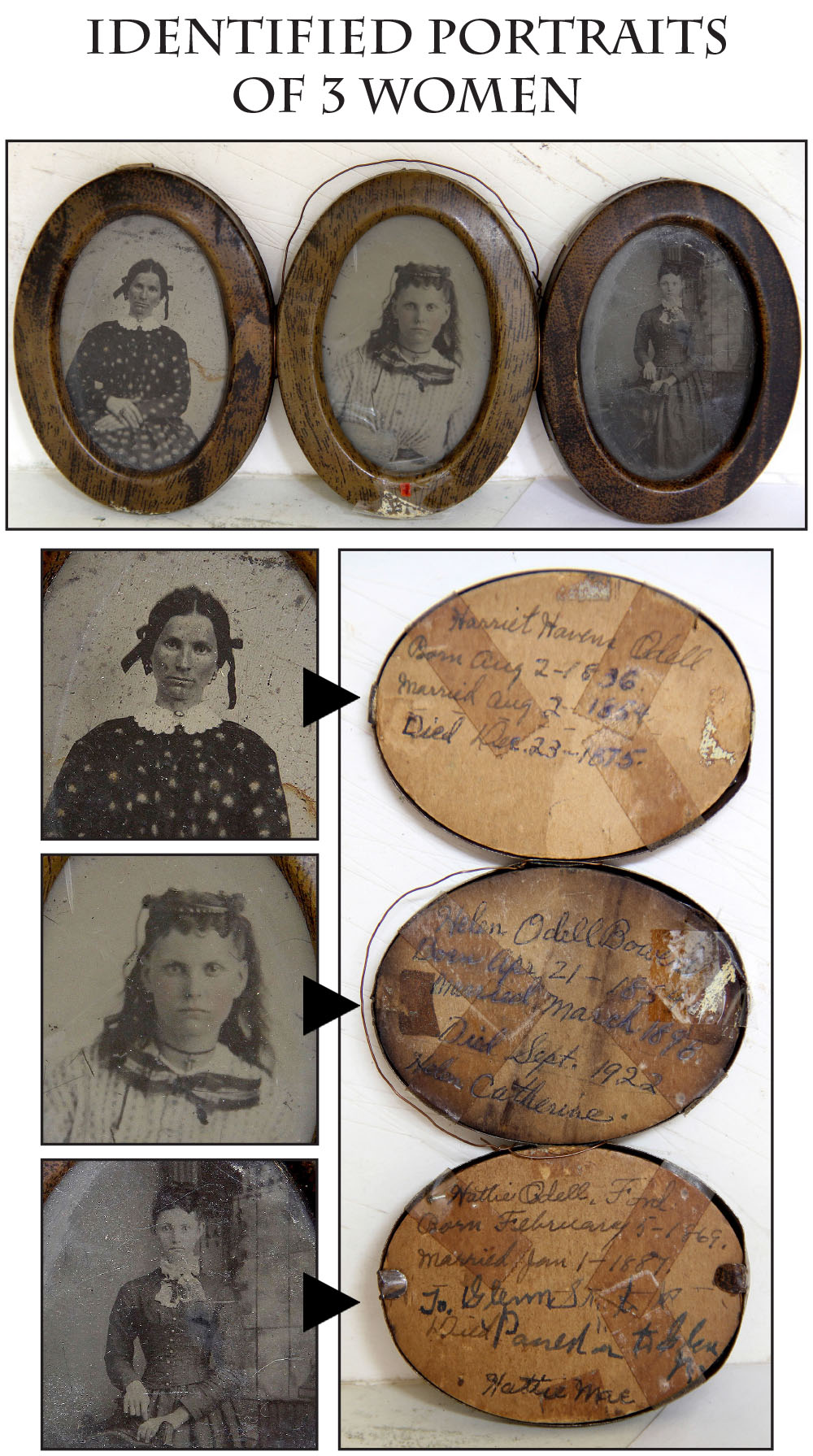
15-09-08 … Three Framed Oval Tintypes of Women from the Odell Family of White Oak Township, Michigan …
This is a nice set of a mother and two daughters with some genealogical information from the family penned on the reverses. The first shows a woman in 1850s style dress identified as Harriet Havens Odell, born in 1836 and married in 1854. The other two are identified as Helen and Hattie Odell along with their married names. Noted on reverse are dates of birth, marriage, and in two cases dates of death. A quick genealogical search turned up the two girls as daughters of James O’Dell and Harriet Havens. Two sons were also listed, who survived to adulthood, but are not in this group. A very touching little group, ready for display, likely kept by Harriet Odell as her daughters moved on to their own independent married lives. Very striking photo display for a very small price … noco
… $55.00 – SOLD
Click Here to E-mail Us!
Call us @ 419-842-1863
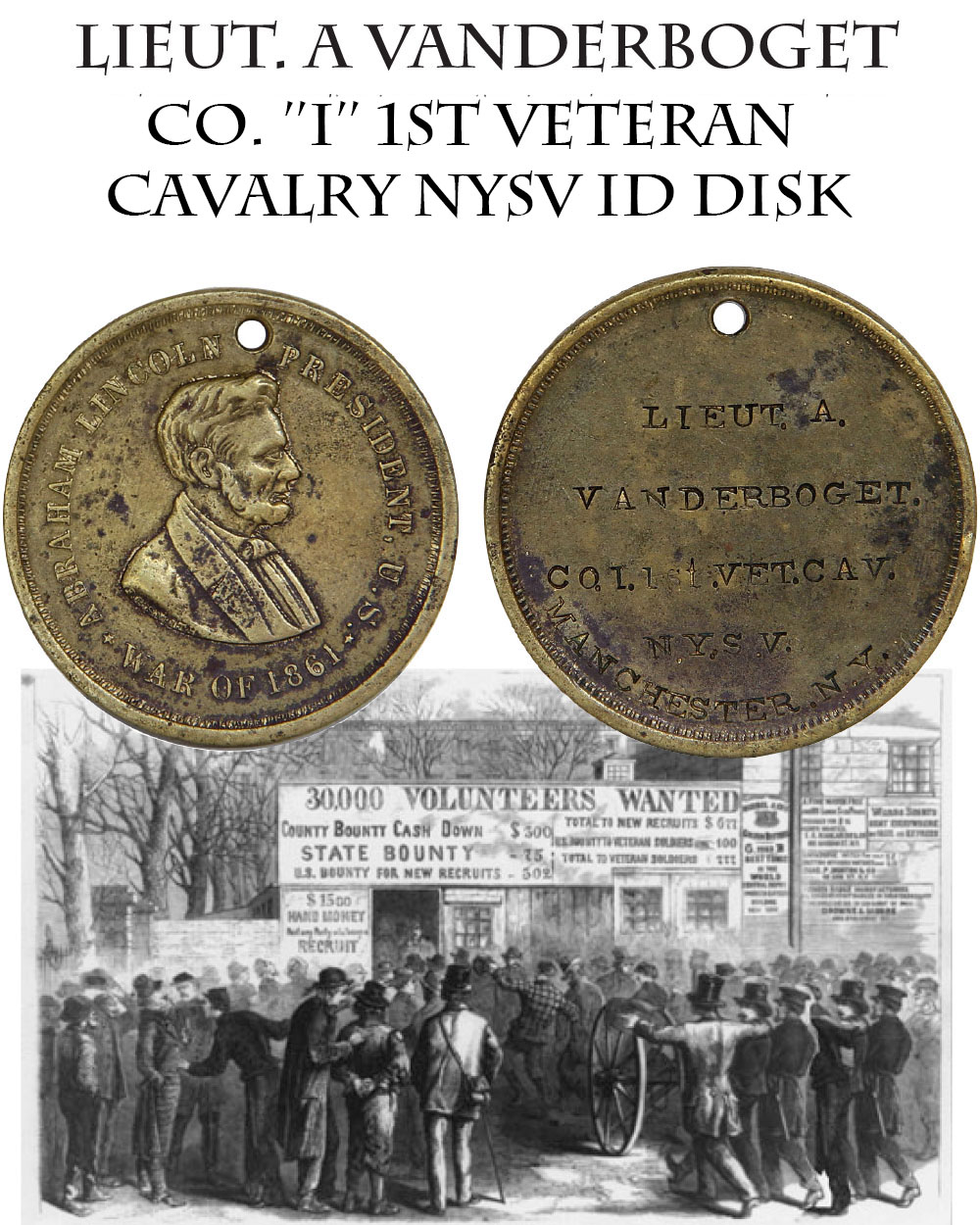
15-09-09 … Scarce Abraham Lincoln pattern Civil War dog tag belonging to Lieut. A. Vanderboget, Co. I, 1st NY Veteran Cavalry …
who was from Manchester, NY, and is so stamped on the opposite side. In a period when the army did not issue its soldiers any ready means of body identification on the battlefield, commercially produced identification disks (dog tags) like this were popular purchases by soldiers in case they were “lost, killed, stolen or strayed,” as one soldier put it. This particular pattern is a scarce version with a bust of Lincoln on the obverse, bordered by the words, “Abraham Lincoln, President U.S. War of 1861,”. The Scovill manufacturing company produced most of the die struck ID discs we now collect. The reverse side of the discs were reserved for stamping by the sutler with the soldier’s personal information. Ours is so marked for Allen Vanderboget who served throughout the war in two different regiments. He enlisted first at age 19 in Newark, NY, in the 17th NY Infantry, a two-year outfit, mustering in as sergeant in Co. I on 5/22/61, and making First Sergeant 11/1/62. He mustered out with his company on 6/2/63 in New York City. He then returned upstate and again enrolled, this time for three years in Geneva, NY, mustering in as 1st Lieutenant of Co. I of the 1st NY Veteran Cavalry 10/10/63. He made Captain 10/21/64 and mustered out with the company 7/2/65. The 1st NY Veteran Cavalry was organized in July, 1863, and served first in the Department of Washington and the 22nd Corps, before becoming part of the cavalry corps of the Army of West Virginia and the Army of the Shenandoah. They lost 4 officers and 32 enlisted men killed in action during their service, which is very respectable for a cavalry outfit, seeing action at Upperville, Snickersville, Piedmont, Waynesboro and other locations. You can’t get a Civil War item much more personally identified than the soldier’s own identification disk and this is an excellent specimen. Wonderful with the Abe Lincoln likeness on the face … fjj-ray
… $975.00 – SOLD
Click Here to E-mail Us!
Call us @ 419-842-1863
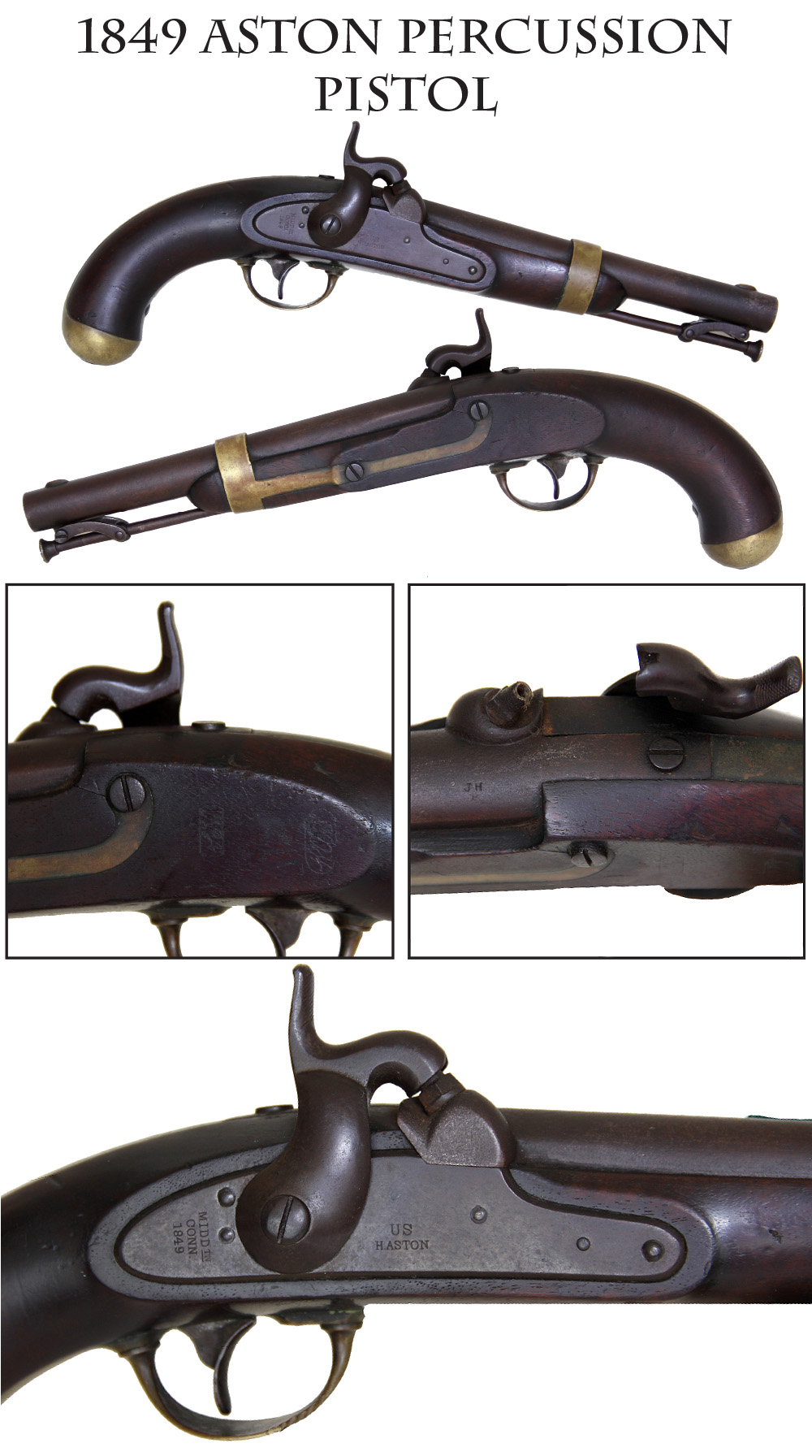
15-09-10 … Stunningly Attractive Attic – Fine Aston Pistol …
I love this gun! An absolutely beautiful, untouched example of the US M1842 single shot percussion pistol dated 1849. Sharp edges, crisp maker and inspector stamps, vivid wood cartouches, smooth, aged, uniform, rust-brown patina on the barrel and lock, and magnificent, undisturbed, deep bronze, suntan patina on the brass. Top shelf condition with higher shelf patina. Orson Welles used to advertise wines that would not be sold “before their time.” This gun waited patiently in a protected desk drawer, or on a forgotten attic shelf, for 150 years before it was time for it to come to light. It has truly aged to perfection. Your Baldacci or Sonoma Loeb may age well, but once you’ve finished the bottle… it’s gone, leaving you only with a tinge of regret, and perhaps a little headache. This vintage pistol will give pleasure to an antique arms connoisseur for decades, never run dry, and always impart a sense of satisfaction in how perfect the patina is. I can appreciate a minty bright gun as much as the next man, but these weapons that age with perfect uniformity in patina are far rarer and much more attractive. I don’t need to go into the history of the 1842 pistol for you. You don’t get many shots at guns in this condition and this gun is still very affordable. … -f?-ny-au
… $1,350.00 – SOLD
Click Here to E-mail Us!
Call us @ 419-842-1863
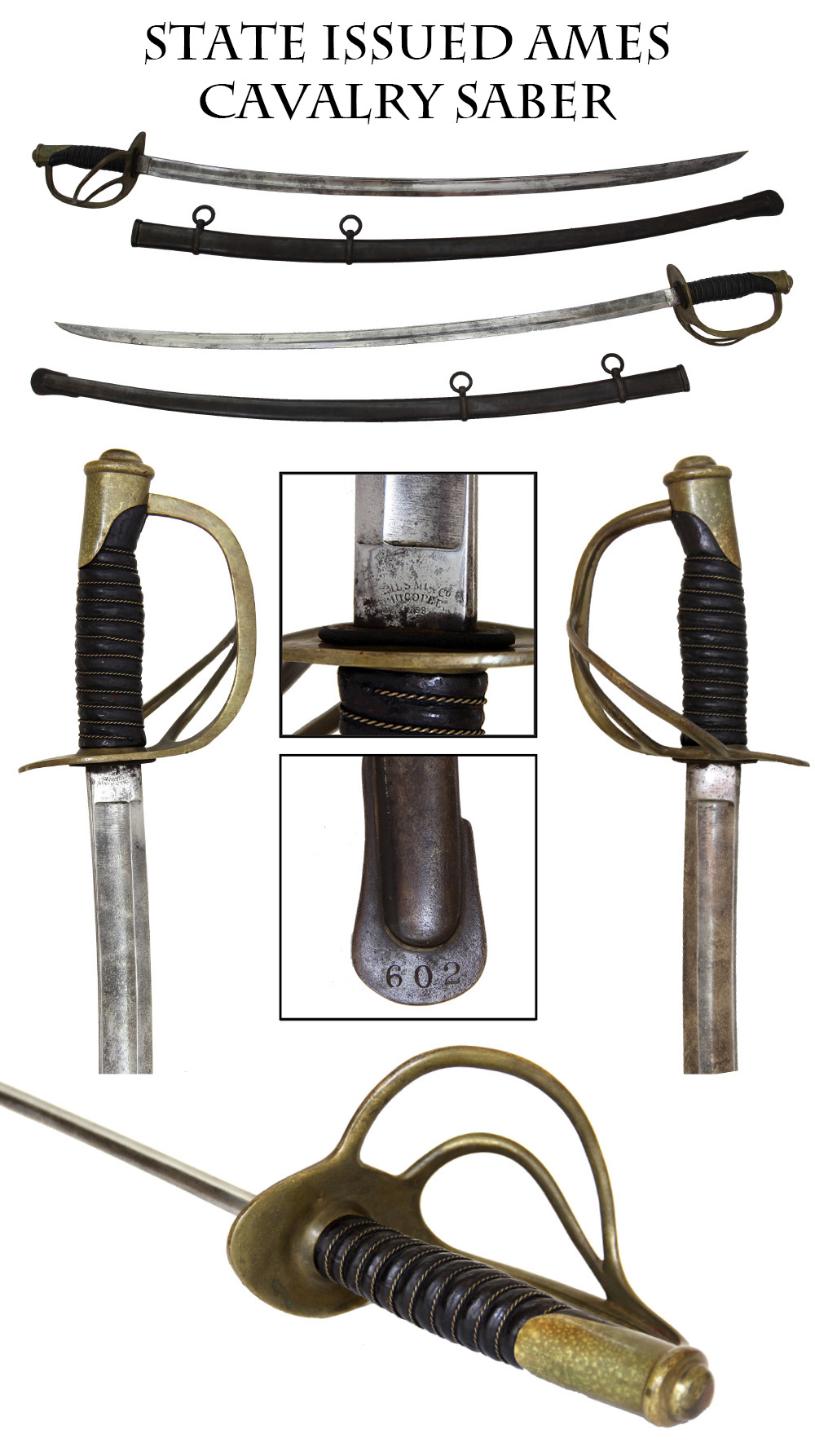
15-09-11 … Non-Federal Issue Ames Light Cavalry Saber …
Undated and uninspected Ames light cavalry saber. We call them the model 1860, but they first appeared in 1857. This has the Ames marking in an arc reading: “Ames Mfg. Co. / Chicopee/ Mass.” on one side of the ricasso and the other side, which would have the US inspector’s initials and date if it were a Federal purchase, is blank, indicating it was purchase privately, by a militia unit, or by a state. Retains the original black leather grip and wire wrap, leather pad at the blade shoulder under the guard. Mellow patina to the brass. Blade is bright mixed with dull silver and some gray clouding, with a proper unsharpened edge and no nicks or pitting. Scabbard is complete with rings, throat and drag, gray overall with some brown coming up and some shallow dappled pitting toward the tip. A rack number “602” is stamped in large numerals on the drag, indicating issue to a unit of substantial size, or residence in a large armory. Most rack numbers are under 100 indicating numeration by company. A number of 602 would be at the regimental level… or perhaps an inventory number in an armory. In any event these state purchased or unit purchased Ames sabers are quite scarce. This one is VG condition and very solid – noco-16759
… $875.00
Click Here to E-mail Us!
Call us @ 419-842-1863
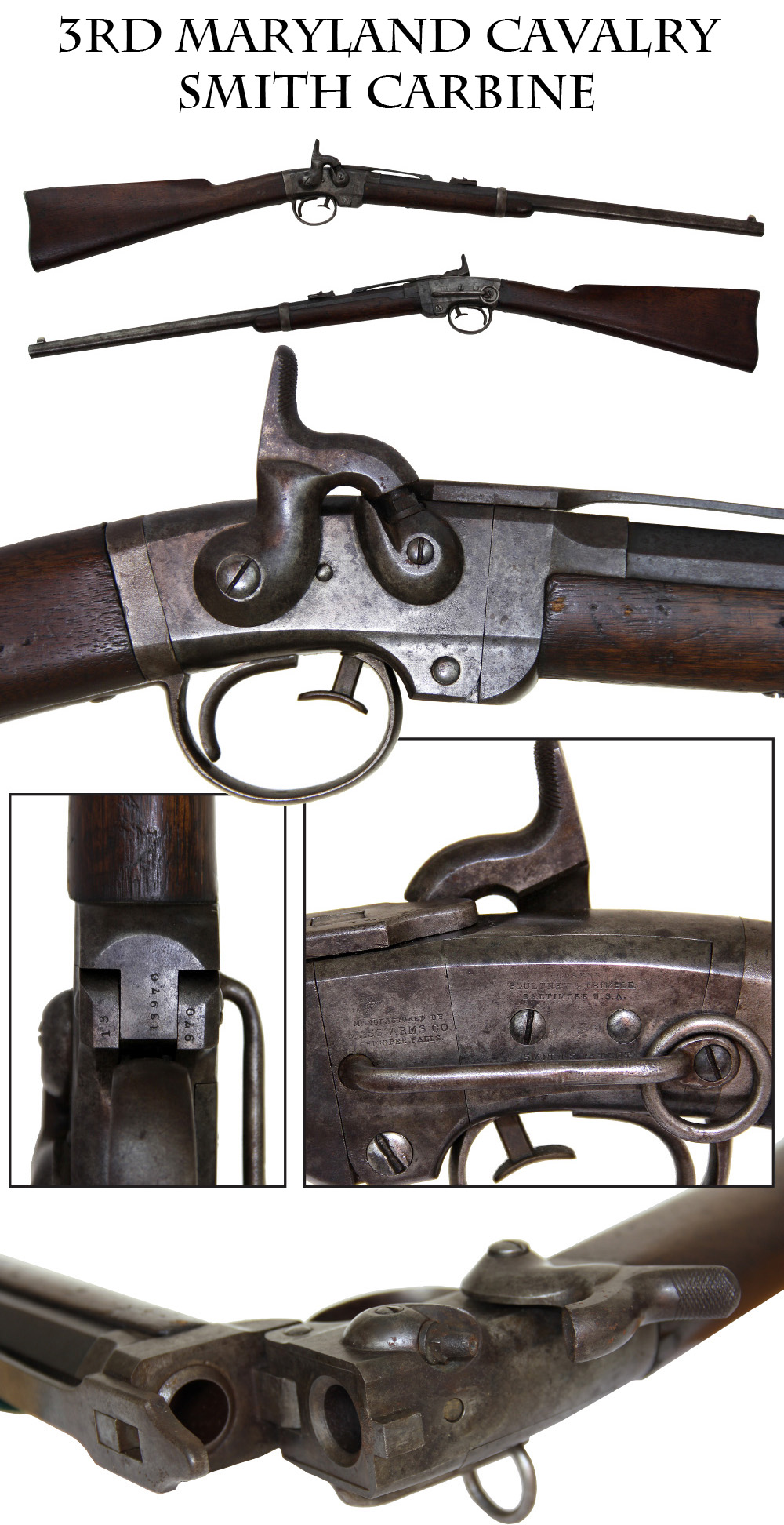
15-09-12 … Smith Carbine by the Massachussetts Arms Company …
15-09-12 3rd Maryland Cavlary Smith Carbine by the Massachussetts Arms Company … I purchased this carbine an a decades old collection a couple months ago. Today, while typing the description I ran the serial number in the Springfield Arsenal Research Services records and was delighted to see that “It Hit”. Government records show this carbine was issued in 1864 to a trooper in Co. “I” 3rd Maryland Cavalry. Here is a cut and paste history of the regiment…
3rd Regiment Cavalry “Bradford Dragoons” …
Organized at Baltimore, Md., August 8, 1863, to January 9, 1864. Attached to Cavalry Reserve, 8th Army Corps, Middle Department, to January, 1864. Unattached, Defenses of New Orleans, La., Dept. of the Gulf, to March, 1864. District of LaFourche, Dept. of the Gulf, to June, 1864. District of Morganza, Dept. of the Gulf, to August, 1864. United States forces, Mobile Bay, Dept. of the Gulf, to December, 1865. District of Southern Alabama, Military Division of West Mississippi, to May, 1865. 1st Brigade, 2nd Division, Cavalry Corps, West Mississippi, to June, 1865. Dept. of Mississippi to September, 1865. SERVICE.–Duty in the Defenses of Baltimore, Md., until January, 1864. Ordered to New Orleans, La., thence to Madisonville, La., and duty there until March, 1864. Expedition to Franklinton February 1-3. Flemming’s Ford, Madisonville, February 11. Ordered to Brashear City March 14 and duty there until June. At Morganza until July. Expedition to the Atchafalaya May 30-June 5. Morgan’s Ferry Road June 9. Ordered to New Orleans, La., July 1. Dismounted July 7. Sailed from Algiers for Mobile Bay, Ala., August 5. Siege operations against Fort Morgan August 9-23. Capture of Fort Morgan August 23. Post duty at Dauphin’s Island and in District of Southern Alabama until March, 1865. Campaign against Mobile March and April. Garrison duty at Fort Gaines until April 30. Ordered to New Orleans, La., April 30, and duty there until June. Ordered to Natchez, Miss., June 20. Duty there and In the Dept. of Mississippi until September. Mustered out at Vicksburg, Miss., September 7, 1865.
… End of Unit History.
Smith carbines were made by three different manufacturers. this one made by the Massachusetts Arms Company and so marked on the left of the receiver forward of the Poultney and Trimble agent markings. This is a very decent gun with thin blue turning brown on the barrel, barrel band, and latch. Both sights in place. Matching serial numbers 13,970. Nice tight breech. Frame is a light steel gray with some hints of mottled grey case color. Wood is very good, with nice visible cartouche. Bright bore. Slight chip at top – rear – edge of the forend, left side, where it meets the frame. Mechanically very good. Retains about 10% faded original finish. A tight solid Smith carbine for your cavalry display, and many times more interesting with the history and provenance of its service in the deep south … ajj-mil
… $2,250.00
Click Here to E-mail Us!
Call us @ 419-842-1863

15-09-13 … 1861 Dated U.S. Christian Commission “Soldier’s Pocket Book” …
Thin brown cloth binding with gilt lettering. Published in Philadelphia in 1861. Some water stains, spine a bit loose, and a piece of the paper lining of the front cover is gone, but this is a typical example of the small inspirational and devotional pocket books handed out to soldiers by religious and charitable organizations. The Christian Commission was perhaps the largest of these, providing essential medical and hospital services to an overwhelmed support system for soldiers at the front. A nice “go-with” item in a camp display or collection of soldier personal effects…dj-or-less
… $79.00 – SOLD
Click Here to E-mail Us!
Call us @ 419-842-1863

15-09-14 … 123 Year Old Model 1873 Winchester Lever Action Rifle …
.32 Caliber, Made in 1892: A very appealing and handsome example of The Gun that Won The West. 100% original, 100% complete, mechanically perfect, good bore, great wood, and sharp markings. NRA “very good” ++ condition. Totally honest and unaltered. This rifle was manufactured in 1892 and bears serial number 422,025B. The cowboys are long gone, but these great old guns live on. This octagon barrel ’73 is a tight and honest example with much appeal. This is about as affordable an old cowboy gun as you can hope to find. My son was just searching the Winchester web site and tells me that modern made 1873s are $1500 and more. Compared to prices of modern guns and replicas of antiques, this offering is a great value for the money … gjj-may
… $1,295.00 – SOLD
Click Here to E-mail Us!
Call us @ 419-842-1863
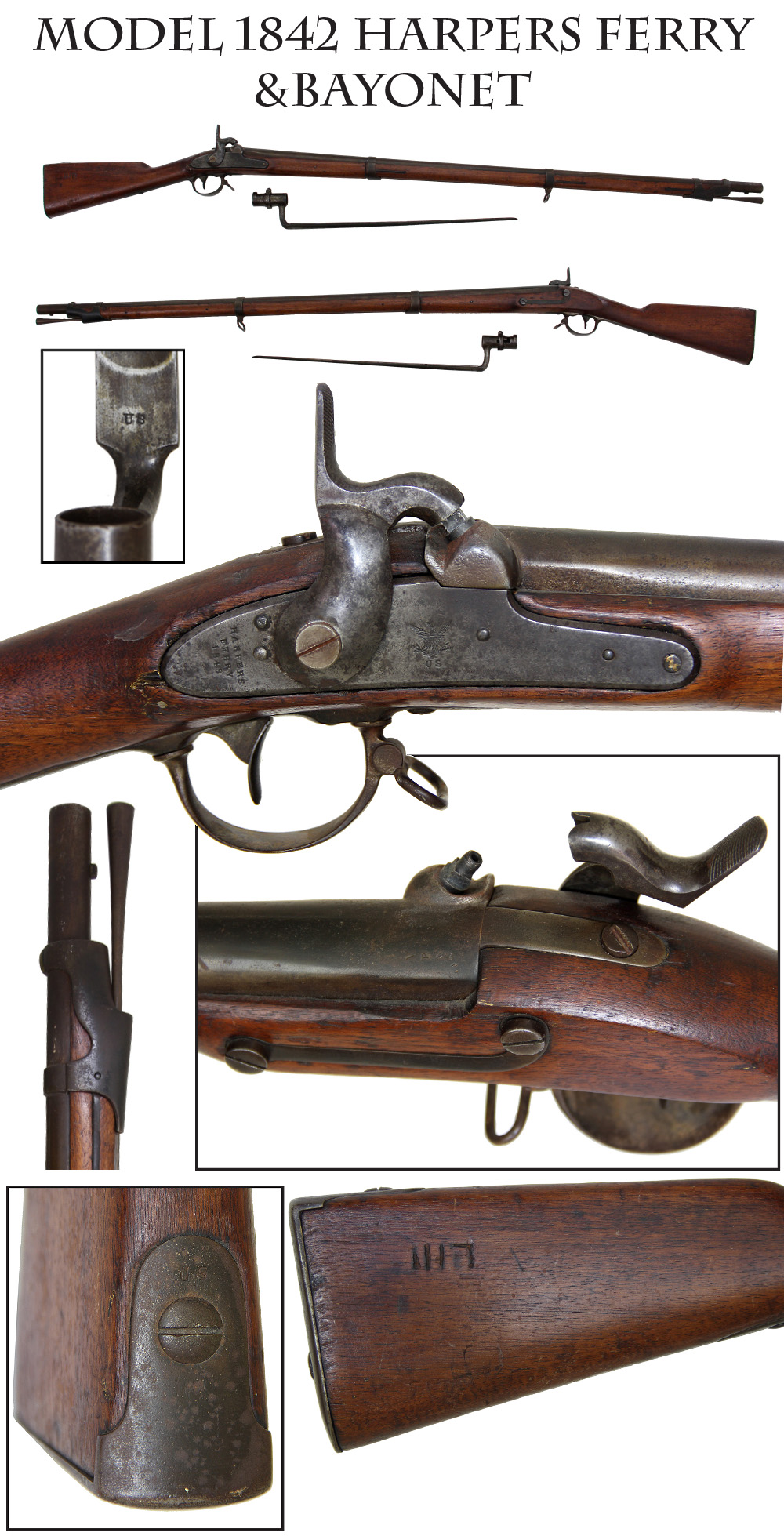
15-09-15 … 1849 Dated Harpers Ferry 1842 Musket with Bayonet …
This was the last of the US .69 smoothbores for infantry of the line and the first of the percussion system for them as well and, of course, Harpers Ferry will always have a bit of romance attached to it as the “southern arsenal.” This has nice light brown tones to the wood and deep pewter and faded brown to the metal. Moderate rounding to the wood edges, traces of a cartouche on the offside. Clear V/P/eagle barrel proofs. Lockplate with mottled faded grey and clear Harpers Ferry markings and 1849 date, making it just after the Mexican War, but made in plenty of time for early service in the west. Some slight pitting to the bolster from firing, but not much surrounding corrosion and a tight wood to metal fit at the breechplug tang. Hammer screw and nipple are older replacements. The rod is a reproduction. Minor chip in wood at rear of lockplate, nice sharp edge along wrist behind the hammer. Three short vertical lines and a “7” carved in the outboard butt stock flat, that could also be an upside down Roman numeral “LIII” (“58.”) Mechanically good, all swivels, bands, springs and bayonet stud in place. With this comes an original .69 bayonet in good condition that has been with it for a long time. A nice example of a U.S. regulation arm firing “buck and ball” that was widely used during the war. Fresh from a local collector’s estate … ejj-may … Bargain priced …
Musket with bayonet … $950.00 or Musket by itself $850.00 … – SOLD
Click Here to E-mail Us!
Call us @ 419-842-1863


15-09-16 … Remington Smoot New Model No.3 …
Five-shot .38 caliber rimfire revolver with hard rubber grips and full nickel finish. Made from about 1878 to 1888, these revolvers were strong competitors in the market for pocket revolvers. Production estimated at 25,000. Some softening to the details of the hard-rubber grips from handling and some dappling to the nickel finish but little flaking or wear- just a spot on the right aft of the trigger and the edges of some cylinder flutes. Clear Remington & Sons and 1873 patent markings on the barrel rib. One of the small revolvers you might notice tucked in the waistbands of western poker players trying their luck, or in the garter of a Saloon Gal who knew her business. An affordable weapon from the days of the cowboy, made by an iconic maker … bej
… $365.00
Click Here to E-mail Us!
Call us @ 419-842-1863
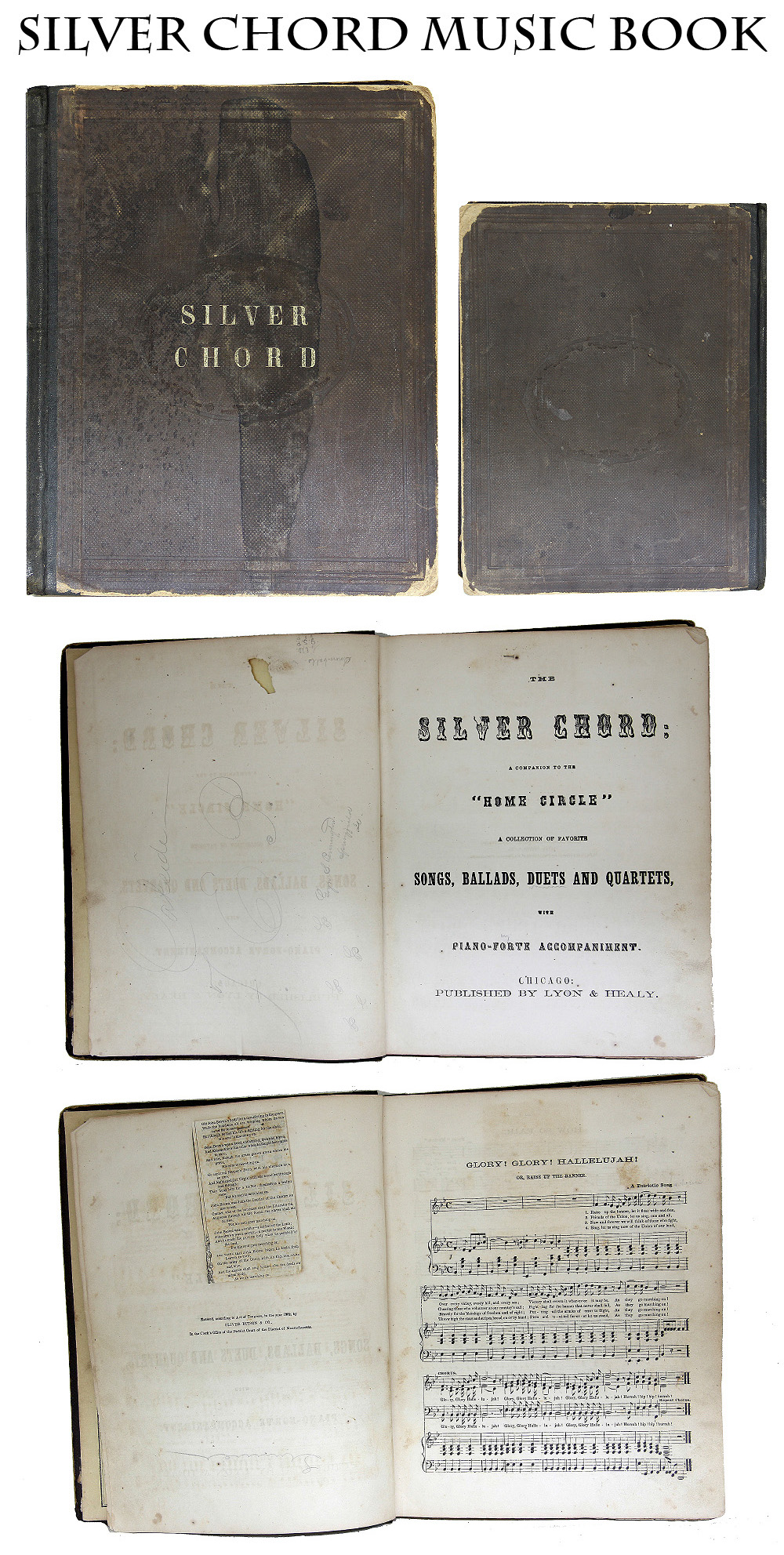
15-09-17 … The Silver Chord …
Large 9″ x 11.5″ hardbound music book with 1862 copyright date. “The Silver Chord… Songs, Ballads, Duets and Quartets with Piano-Forte Accompaniment.” Includes
Glory Glory Hallelujah, The Officer’s Funeral, The Star Spangled Banner, Bonnie Dundee, The Battle Prayer, The Child of the Regiment
… and dozens more. 201 pages of music for self made entertainment during the Civil War. Definitely a vestige of a more innocent age. We are so used to music and other forms of entertainment being shoveled in front of us that we forget there was a time when you had to create it yourself. VG overall with some looseness on the covers … noco
… $125.00 – SOLD
Click Here to E-mail Us!
Call us @ 419-842-1863
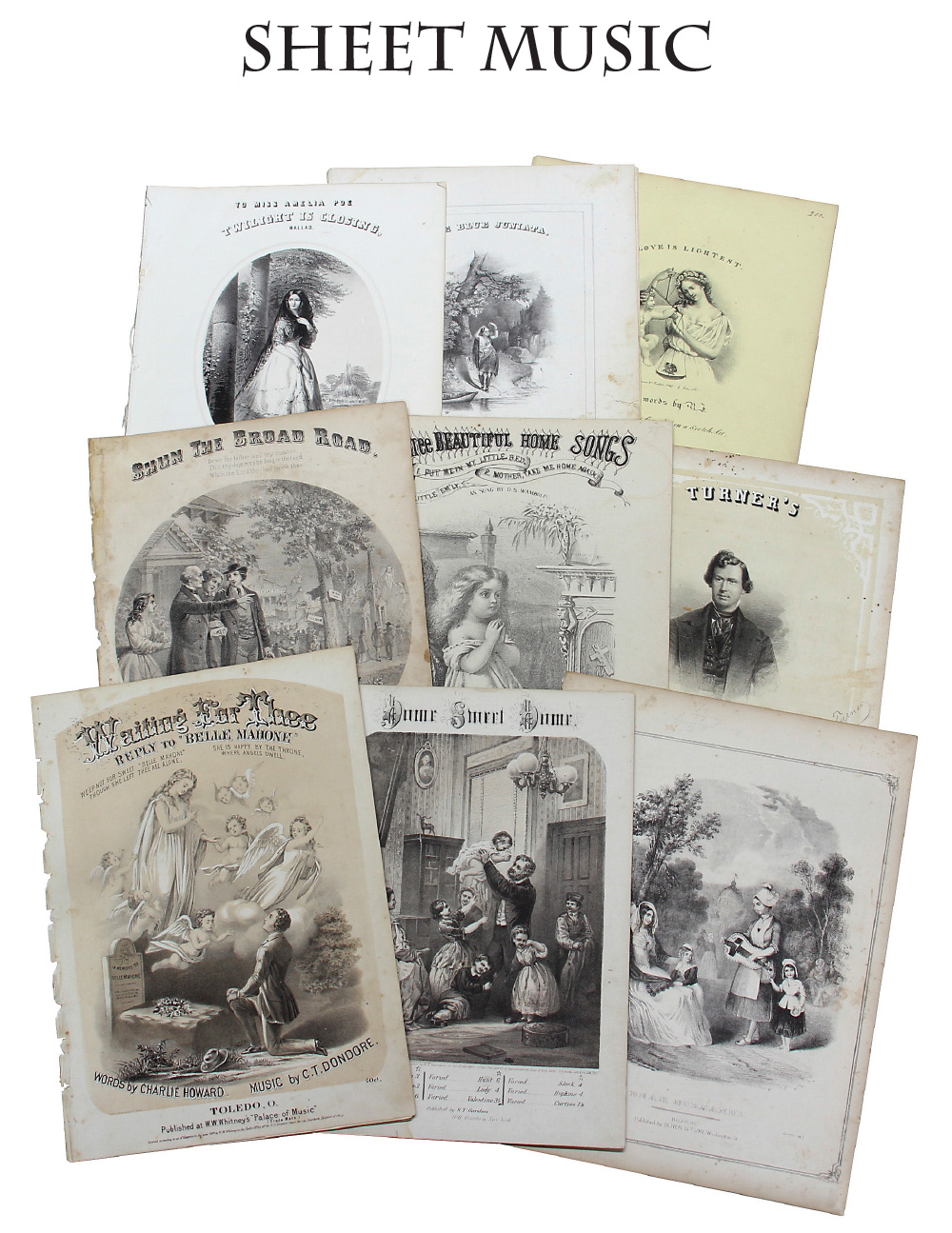
15-09-18 … Sheet Music with Good Graphics …
I have a nice selection of Civil War or slightly earlier sheet music with nice graphics on the covers. I believe I have around 30 pieces. Aside from “Home Sweet Home” the titles, and lyrics, will probably not be familiar. (You can be the first one on your block to introduce these CW tunes to the neighborhood.) They tend toward the romantic and sentimental. Many are reminders of the fragility of life in nineteenth century America, and they would look good framed or even in a collection as examples of life on the homefront. There are certainly many stories in soldier letters of visits to local houses during lulls in campaigning where singing in the parlor was a welcome break in army life. For those stationed on the frontier it was one of the few wholesome recreations available to stave off boredom. Each piece has a nice cover graphic … noco …
Priced each $15* … Two for $25* … Five for $65*
*my choice
Click Here to E-mail Us!
Call us @ 419-842-1863

15-09-19 … 34th New Jersey CDV…
Nice two-thirds length seated view of William Hudson Lawrence, 34th New Jersey and Brevet Brigadier General. Crisp view with nice tones of Lawrence in an officer’s sack coat with double-bordered major or lieutenant colonel straps. Lawrence was a New Jersey native who signed up as a private in the 7th NY State Militia and then joined the 14th US Infantry 5/14/61 as a First Lieutenant, making Captain 10/25/61, and was discharged for promotion to Colonel in the 34th New Jersey on 11/9/63. He served until 8/3/65, receiving army brevets as Major and Lt. Col. and finally a brevet as Brigadier-General of Volunteers (all dating to March 13, 1865) for gallant and meritorious service. The 14th US served in the 5th Corps while Lawrence was with them and he is mentioned in the ORs as commanding Co. F of the second battalion of the 14th US at Chancellorsville and some additional research might turn up some other good details on him. Lawrence took a leave of absence to command the 34th NJ and tried to get it attached to the Army of the Potomac, but it ended up being stationed in Kentucky, where it took part in several skirmishes and one “sharp action” at Clinton, KY. It was transferred to the Department of the Gulf in April, 1865, where it took part in the assault on Spanish Fort and other Confederate fortifications, where it lost 3 killed and 15 wounded. The photo is exceptionally clear and has a Weitfle’s, Newark NJ photographer’s backmark. The identification is modern pencil, but is confirmed by a photo in Roger Hunt’s illustrated book “Brevet Brigadier Generals.” . Nice CDV … lot429-cow
… $125.00
Click Here to E-mail Us!
Call us @ 419-842-1863

15-09-20 … New Jersey Battle Hero …
Vignetted bust shot CDV portrait of Brevet Brigadier General Caldwell Keppele Hall. Period ink id on reverse: “C.K. Hall / Lt. Col. 14th N.J.V.” Moses, Trenton NJ, Photographer backmark. Caldwell enlisted as a private at Trenton on 4/16/61 and mustered into Co. A of the NJ National Guard Infantry, with whom he served for three months. He was then commissioned as First Lieutenant and Adjutant of the 5th NJ on 8/28/61. He was discharged for promotion 8/25/62 and commissioned Lt. Colonel of the 14th New Jersey 8/27/62. He was detailed as Aide de Camp to Brigadier General Patterson at a date not stated and was wounded in action at Monocacy 7/9/64 and was discharged for his wounds 9/10/64. He received brevets as Colonel and Brigadier General to date 3/13/65. Author Roger Hunt also indicates he served on the staff of General Joseph Carr as 1st Lt and acting Aide de Camp, presumably while he was in the 5th New Jersey … lot429-cow
… $150.00 – SOLD
Click Here to E-mail Us!
Call us @ 419-842-1863
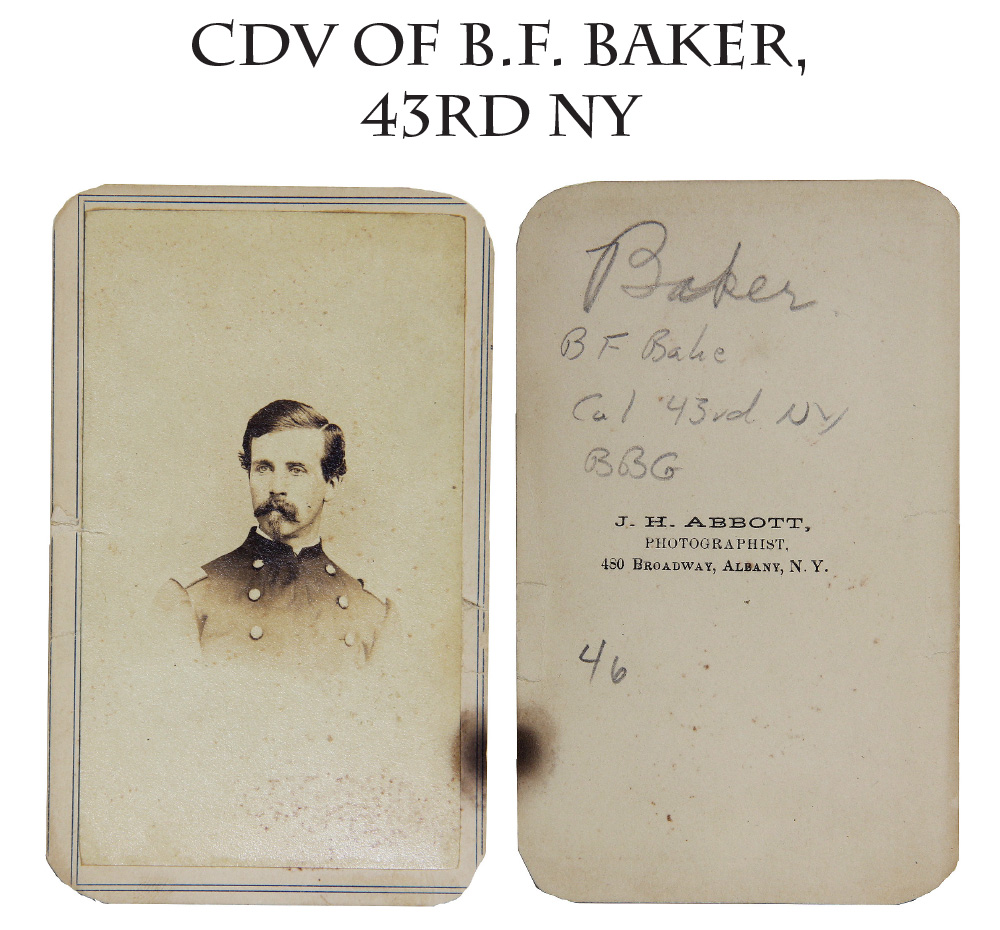
15-09-21 … 43rd New York Battle Commander …
Vignette mid-chest view of Benjamin Franklin Baker, Colonel of the 43rd New York and Brevet Brigadier General. Baker was 27 when he enlisted in New York City as a Major on 9/20/61 and was commissioned in the 43rd NY, the nickname of which was the “Albany Rifles.” He made Lt. Colonel 9/24/62 and Colonel the next day, 9/25/62. He served until resigning 2/1/64 and received a brevet as Brigadier General 3/13/65 for faithful and meritorious service. During Baker’s service with the regiment the 43rd served in the Army of the Potomac, spending most of its time in the 6th Corps. On the Peninsula it suffered casualties at Gaines Mill and Savage Station, losing 71 in killed, wounded and missing during the Seven Days Battles, and during the Chancellorsville campaign lost 138 men at Salem Church and 66 in the assault on Maryes Heights. At Gettysburg it was lightly engaged, at Rappahannock Station in the Fall of 1863 it took part in the successful assault on Confederate works. Baker was born in 1834 at Albany and died in 1907 at Burnt Hills. Small scrape on left side … lot386-cow
… $125.00 – SOLD
Click Here to E-mail Us!
Call us @ 419-842-1863

15-09-22 … CDV of Col. Lewis T. Barney, 106th NY – Youngest BVT Brigadier General in the Army! …
Nice length standing portrait of Lewis Tappan Barney, the youngest Brevet Brigadier General in the entire Union army. Born in 1844, Barney first enlisted and mustered into the 7th NY State Militia on 5/25/62 as 1st Lt. in Co. F, from which he mustered out 9/5/62. He was commissioned shortly after that in Co. D of the 68th NY on 11/20/62, with whom he served until 2/29/64 when he was discharged for promotion and commissioned in the Adjutant General’s Department of the US Volunteers, from which he resigned 6/21/64. He was then offered a commission as Colonel of the 106th New York, but declined it. He had been granted authority by the Governor to recruit the 180th New York on May 24, 1864. The regiment failed to organize, however, and the one company recruited was sent into the 179th NY, Barney did not receive a commission, and his authority to raise the unit was revoked in August. He is listed as a Captain at one point, probably during his service in the Adjutant General’s Department, when he served on the staff of General Rufus Saxton as AAG. He was apparently well regarded. He received brevets dated to March 13, 1865, both as Brigadier and as Major General. After the war he moved to California and died in Inglewood in 1904. Barney is shown wearing “full-bird” colonel straps in this R.A. Lewis, NY, backmarked card with very nice tones. The image bears a tax stamp and was obviously taken when it was thought his commission as a volunteer full bird Colonel would come through. The card bears the handwritten identification by author Roger Hunt. A very nice image of the youngest Brevet Brigadier General … lot386-cow
… $225.00 – SOLD
Click Here to E-mail Us!
Call us @ 419-842-1863
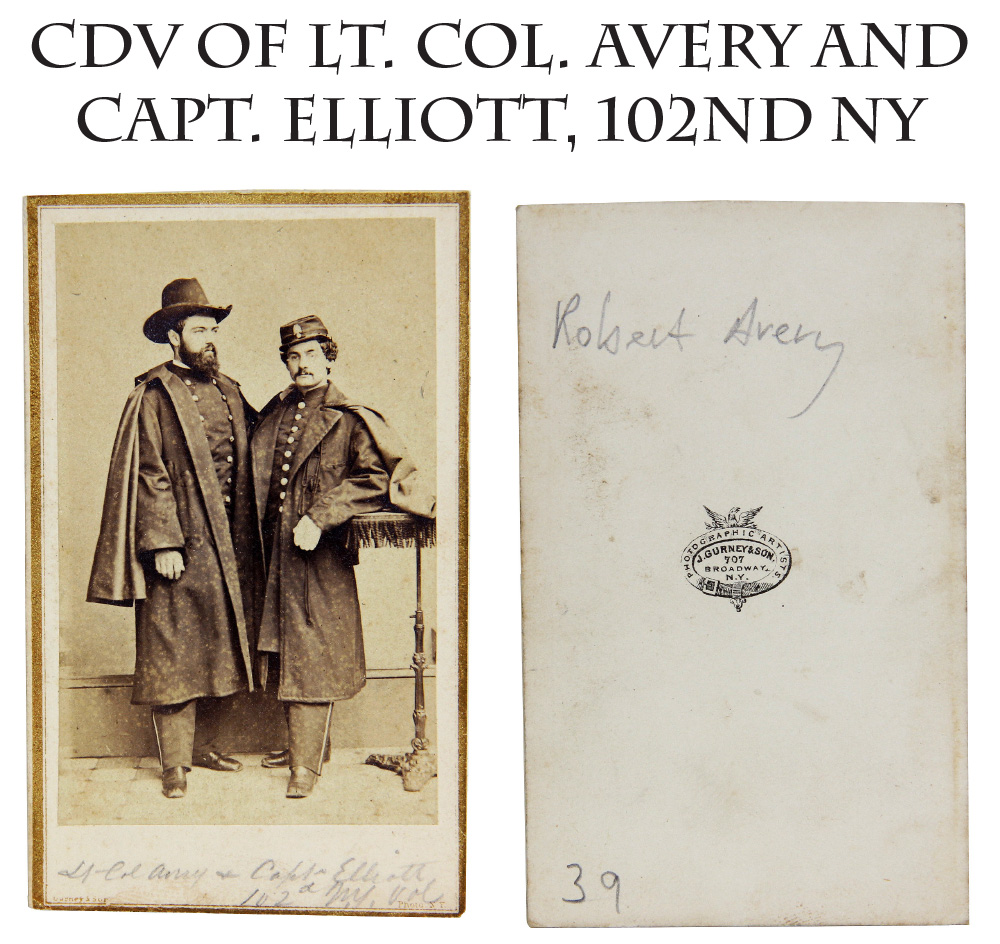
15-09-23 … Battle Heroes & Casualties/ Brevet Brigadier General …
Wounded in Action and KIA Captain of the 102nd NY: Outstanding Civil War Portrait. A wonderful pose. Two officers standing close together by Gurney and Sons of NY, identified on the bottom front in period pencil as “Lt. Col. Avery & Capt. Elliott 102d N.Y. Vols.” Both officers wear cloak coats, Avery in a field grade frock with a slouch hat and Elliott in a line officer’s frock with a kepi sporting what appears to be an Ordnance Department flaming-bomb insignia on the front. The 102nd NY served in the Army of the Potomac, the Department of the Shenandoah, the Army of Virginia and then back in the Army of the Potomac as part of the 12th Corps,… which eventually went west and became part of the 20th Corps. During the service of these officers, the regiment took casualties at Cedar Mountain, Antietam, Chancellorsville, Gettysburg and Lookout Mountain. They lost 7 officers and 67 enlistedmen killed or mortally wounded. Avery was twice wounded. He enlisted at age 22 on 9/12/61 as Captain of Company A 12th NY State Militia. He was assigned to the 102nd NY in January, 1862 and commissioned Captain 5/1/62 with rank from 10/26/61. He was then promoted and commissioned Lt. Colonel in December, 1862. The regiment served in the Army of the Potomac, and then the Department of the Shenandoah and the Army of Virginia, before returning to the Army of the Potomac as part of the 12th Corps in September, 1862. Avery was wounded at Chancellorsville 5/3/63 and again, severely at Lookout Mountain in Tennessee on 11/24/64, which resulted in the loss of his right leg. He was discharged for wounds, but saw subsequent service as a Major in the Veteran Reserve Corps. He joined the regular army in 1866 as a lieutenant in the 44th Infantry, but was unassigned in 1869 and retired with the rank of Lt. Col. in 1870. He received several brevets for his service: Lt. Col. of Volunteers 3/13/65 for gallant and meritorious service at Chancellorsville; Colonel and Brig. Gen. of Volunteers for the same at Lookout Mountain, and Major General of Volunteers for gallant and meritorious service. He also received regular army brevets: Captain for his Chancellorsville performance and Major for Lookout Mountain, both awarded in 1867. There were two captains named Elliott in the regiment, but their dates of commission and a photo in CWData makes clear this is Gilbert Malleson Elliott, who enrolled at age 21 on 10/3/61 at New York City for three years and mustered in as 1st Lt. of Co. D in the 102nd NY on 10/31/61. He was promoted Captain of Co. H 10/5/62 and Major 3/18/63. At the Battle of Lookout Mountain, where Avery lost his leg, Elliott was killed in action. The ordnance insignia on his cap likely indicates he was assigned to the division or corps staff as ordnance officer at some point. His individual service record would likely provide specific dates. A very nicely composed image of two officers with incredibly heroic service records A superb Civil War CDV with top shelf history … noco
… $395.00 – SOLD
Click Here to E-mail Us!
Call us @ 419-842-1863

15-09-24 and 15-09-25 … 2 French Model 1860 Shako Hats …
French Model 1860 Military Shakos imported from France in 1861 for use by Union regiments in the Civil War. In 1861 the War Dept ordered
10,000 complete chasseur uniforms. They were issued to several Northern regiments including the 83rd Pennsylvania, 18th Mass., and 72nd New York as well as some militia units.
Major General McClellan ordered them in conjunction with the French Chasseur uniforms. The Shako is black leather with leather “V” shaped reinforcements on either side and leather bands reinforcing the top and bottom. The short visor is black. The brass cap plate depicts an American Eagle with outstretched wings sitting atop crossed canons and arrows and an olive branch which encircles an infantry bugle. The red, white and blue national cockade, which is above the cap plate, is present on our left example, however missing on the right. The pompon, usually present in its day, is likewise missing. There are vents on either side of the Shako, both are black painted tin on the outside and brass inside – and present on both of our examples. Our right example has a brownish patina to the body of the hat, and a break in the leather around back, shown in an image above. Interior straps present in our excellent left example, are also missing on our right. You can see some damage on the left side of the visor on our left example, where none is present on the right example. On the underside of visor of said left example is the letter “D” and above that a number “7” … the right example features a letter “G” in the same area and the number “5” inside the hat. Both are great additions to any collection and each is priced more than fairly.. Excellent example $795.00 Good example $450.00
15-09-24 … Excellent Example Shako (hat on left)
… noco
… $795.00
15-09-25 … Good Example Shako (hat on right)
… noco
… $450.00
Click Here to E-mail Us!
Call us @ 419-842-1863
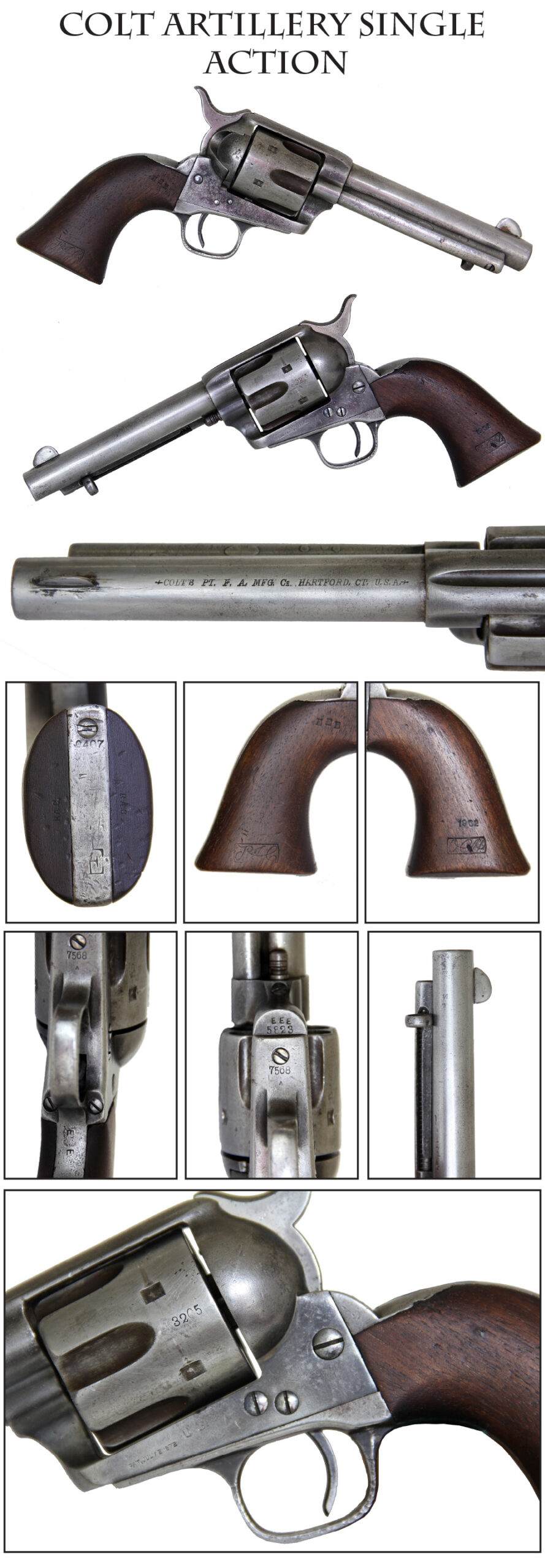
15-09-26 … Colt Artillery Single Action Army Revolver w/ EARLY Serials …
When the army decided to reduce the barrel length of the iconic Colt single action army revolvers from 7 inches to 5 inches it recalled those in the field for refurbishing. Since the parts were interchangeable it made no difference to the government that serial numbers were mixed in the reassembly process. Mixed serials are absolutely correct and proper on this gun. These reissued revolvers were associated with artillery issues by early collectors and the name “Artillery Model” has stuck despite the fact that they were also widely issued to cavalry units, including the Rough Riders in 1898. This revolver has numbers in the 3000, 5000 and 7000 range, indicating it was largely made up from guns from the desirable Custer-era first contract for 8,000 delivered by March 18, 1874. The gun is overall in the bright, having been burnished by an earlier collector. Colt barrel address is crisp and is from the early Ainsworth era with the legend executed in slanted italic letters. The serial numbers are clear. US government ownership stamp on the left frame beneath the cylinder with the upper 1871 patent date very light, but the lower line 1872 date visible. Grips are very good with just a little wear on the bottom right, but clear cartouches including RAC (Rinaldo A. Carr) inspector cartouche on the left side of the grips and RAC stamp on the bottom, and an “OCH” inspector mark for Odus C. Horney, the army’s ordnance inspector from 1901to 1903. Above Horney’s cartouche is the 1902 date indicating the year the gun was refinished. The front sight may have been re-shaped but I cannot tell for sure, and it is not a significant issue. A large “E” is stamped on the butt strap and the letters EEE are repeated in smaller form on the right grip shoulder and underside of the forward frame, meaning unknown to me. A classic Colt Six Shooter that still functions well and is priced realistically. There is no question this gun saw service from the wild west 1870s right up to the Spanish American War and Phillipine Insurrection. A good solid old Colt … bd-17176
… $3,250.00 – SOLD
Click Here to E-mail Us!
Call us @ 419-842-1863
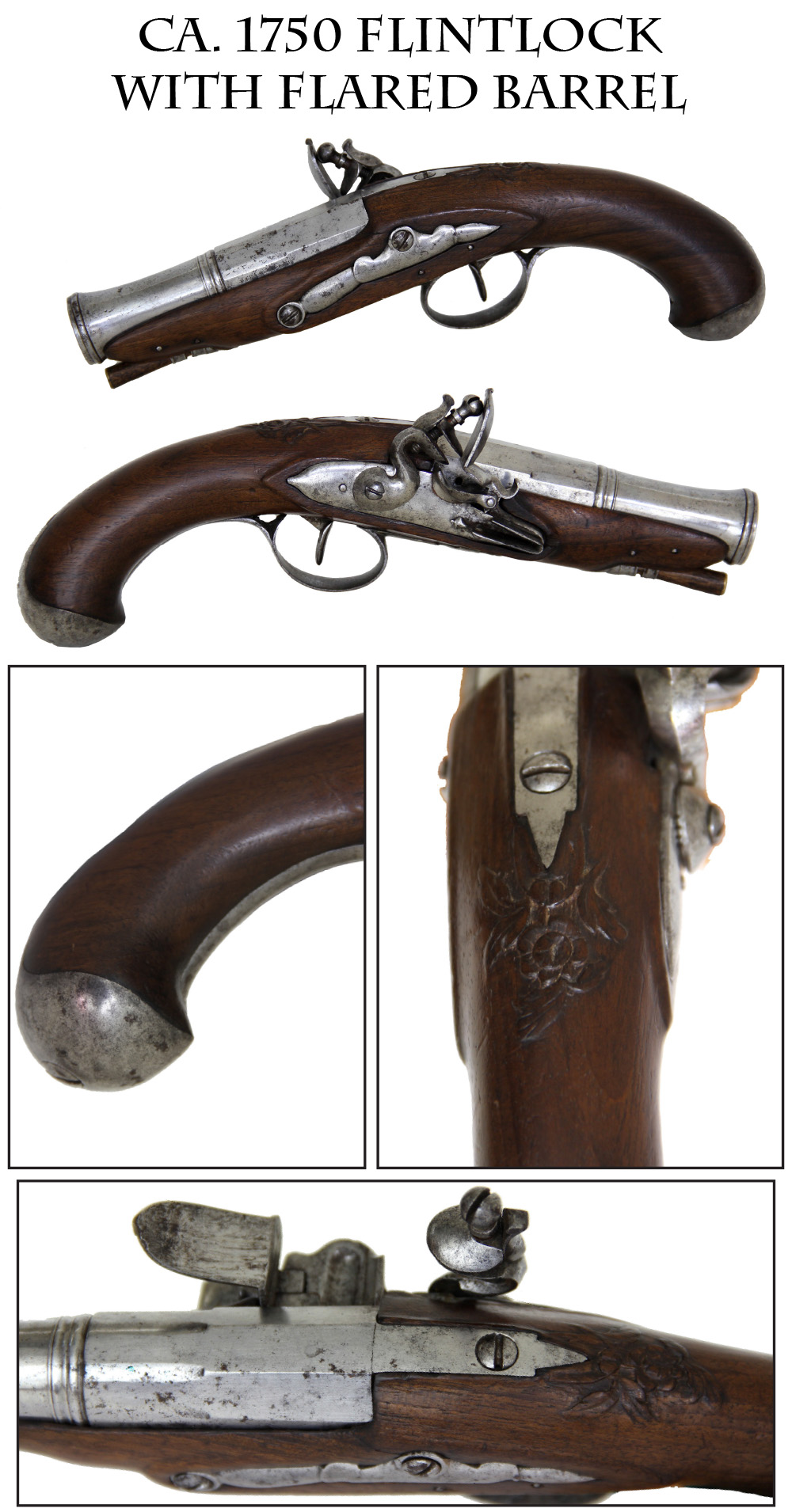
15-09-27 … ca. 1750 Flintlock Pistol with Blunderbuss Barrel …
An elegant little pocket pistol with a three stage barrel, a baluster ring between the first and second, and a flared muzzle that might give an opponent pause in an altercation. Rounded hammer and lockplate, nice edges to the lock platform and raised carving on the apron around the breachplug tang. Birds-head butt cap, short wood rammer held by a narrow thimble and base. Metal is bright with just some scattered gray age spots, no pitting. Side plate secured by two screws, in a sort of abstract cloud formation. Overall about fine condition. All original and complete with possible exception of the ramrod. Unmarked on any exposed parts. A truly great display item, that was obviously meant for real business if needed. Roughly nine inches overall with four inch barrel. Mid to Late 18th century. $1,350.00 … 4″ barrel, 9″ overall length
… $1,350.00 – SOLD
Click Here to E-mail Us!
Call us @ 419-842-1863
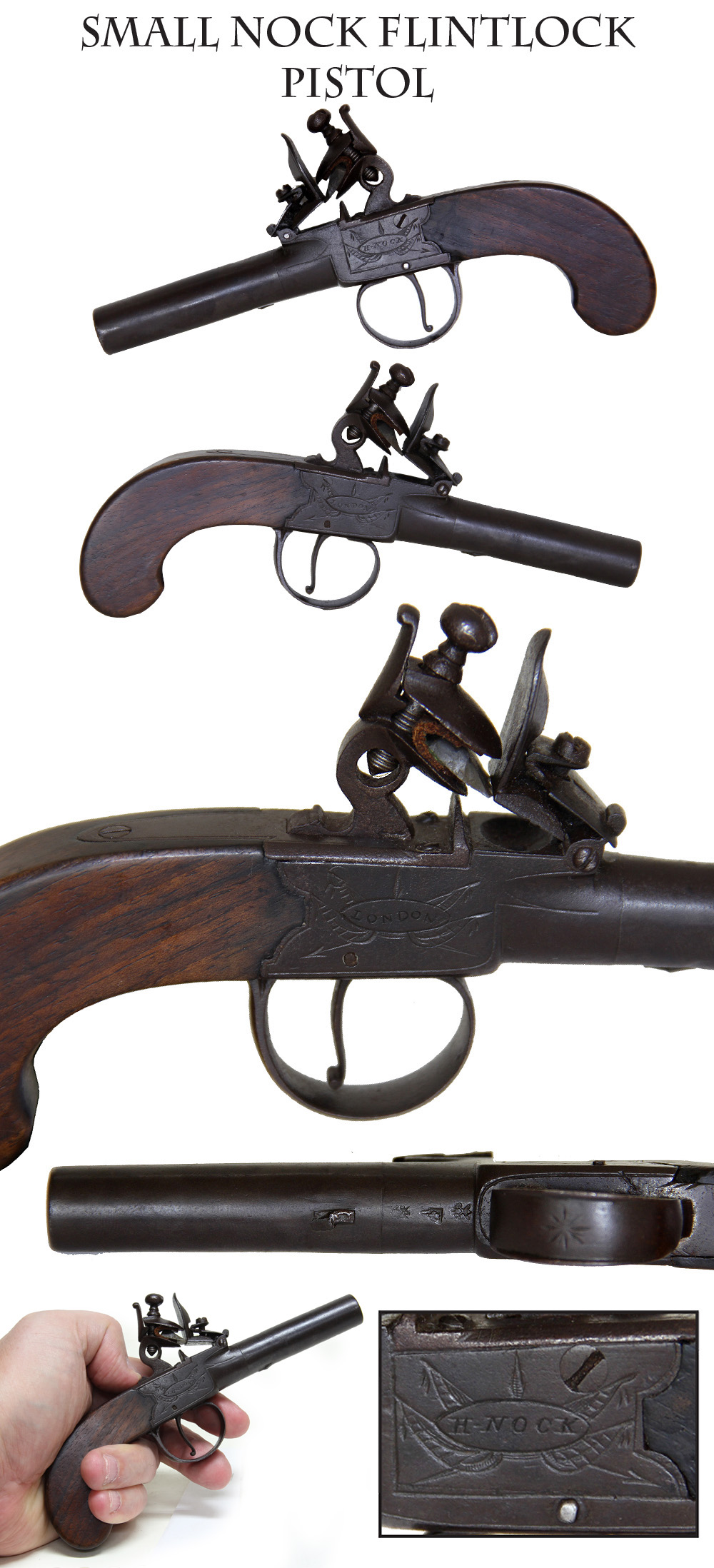
15-09-28 … Flintlock Turn-Off Barrel Pocket Pistol by Nock …
Small flintlock overcoat or pocket pistol nicely marked “H. Nock” on one side of the frame and “London” on the other, both in elliptical cartouches surrounded by flags and spears. 6.75 inches overall with 3 inch barrel. Has typical “turn-off” barrel that would unscrew for loading from the breech, small chip on the barrel lug on the bottom. Barrel proofs on forward underside of frame, starburst decoration on the triggerguard. Tight wood to metal fit, plain flat-sided grips with no chips, mechanism functional. Uniform blue brown patina on the barrel, some light corrosion on the base of the hammer, top of frame, etc. Probably dating about 1825, these were convenient pocket pistols for going abroad and are also referenced as being last ditch weapons carried by some military officers: In close-in fighting aboard ship Stephen Decatur killed an opponent who had wounded him with a pike by drawing “a small pistol from his pocket” as they wrestled on the deck. Overall VG condition … noco
… $695.00 – SOLD
Click Here to E-mail Us!
Call us @ 419-842-1863

15-09-29 … S&K Saber Bayonet …
Nice example of the Schnitzler and Kirschbaum saber bayonet. 23 3/4″ blade … 28 1/2″ overall length. Mellow patina to the brass hilt, functional locking ring. Blade is very good with no nicks, overall bright with just scattered age graying. Rack number 98 stamped on the guard and upper grip. These are often identified as Colt revolving rifle bayonets and they usually fit that gun, but they were used on a number of other rifles as well. The presence of an “Anchor/DC” stamp on the ricasso and guard on this one pegs it as for the “Brazilian Light Minie Rifle,”. This is the Belgian made rifle on the Enfield pattern variously termed “Minie Rifle of Liege Pattern” and “Belgian rifle of Enfield pattern.” About 6,000 of these were imported into this country and supplied to the government on contract by C.K. Garrison. The guns occasionally show up with Ohio stamps and in photographs in the hands of engineer troops and, if memory serves, next to a Confederate casualty in the trenches of Petersburg. A relatively scarce bayonet in VG condition … noco
… $235.00 – SOLD
Click Here to E-mail Us!
Call us @ 419-842-1863

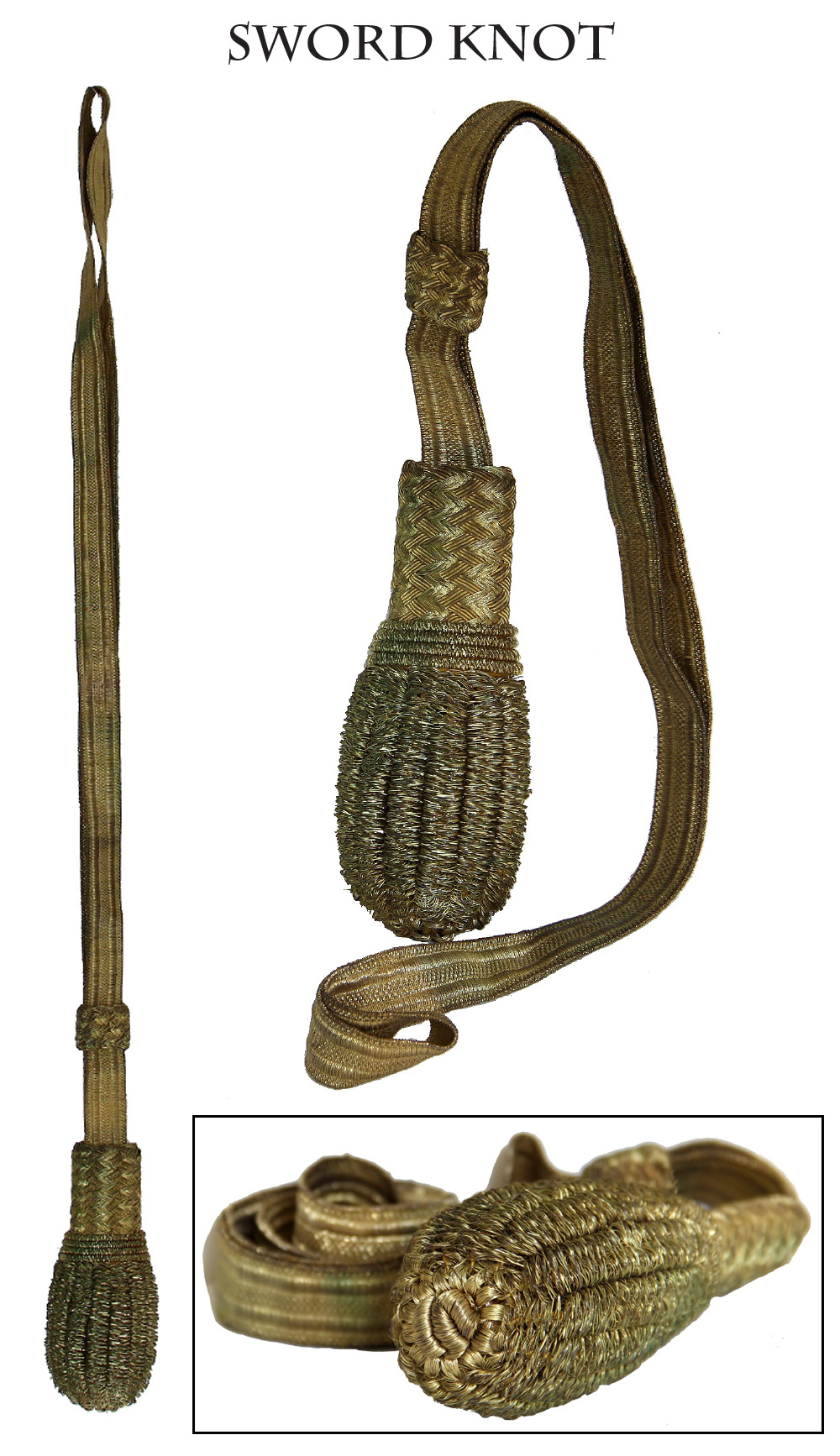
15-09-30 … Superb Condition Gold Bullion Sword Knot …
Civil War officer s sword knot. Like the officers swords themselves, their sword knots were all privately purchased and commercially available from military goods dealers who supplied different types that conformed generally to regulations. An officer might use a leather knot in the field, but dress regulations specified gold bullion and here is a great example, showing only light handling … noco
… $195.00 – SOLD
Click Here to E-mail Us!
Call us @ 419-842-1863

15-09-31 … Pittman Marked Cavalry Cartridge Box …
Regulation issue cartridge box for the cavalry carbine. These boxes were issued to troopers for use with many different carbines. A wood block bored with twenty holes kept the rounds intact while the trooper was galloping around and an inner and outer flap kept them dry and in place. This block is not present in this box. Until very late in the war the boxes still had provision for a shoulder strap, but they seem to have always been worn on the waist belt and occasionally the carbine sling. This one was actually issued and carried: two slits in the cover show where a trooper at some point added a cartridge box plate. Both belt loops, the cross-loop, and the latch tab are in place. Both buckles are there, but the tab securing one has a tear on one side. Crackling and some loss to the exterior finish, the interior is good. Very clear Pittman stamp. Tool pouch, flap and tab are intact. A pretty basic, and essential, cavalry accoutrement pouch
… $150.00
Click Here to E-mail Us!
Call us @ 419-842-1863
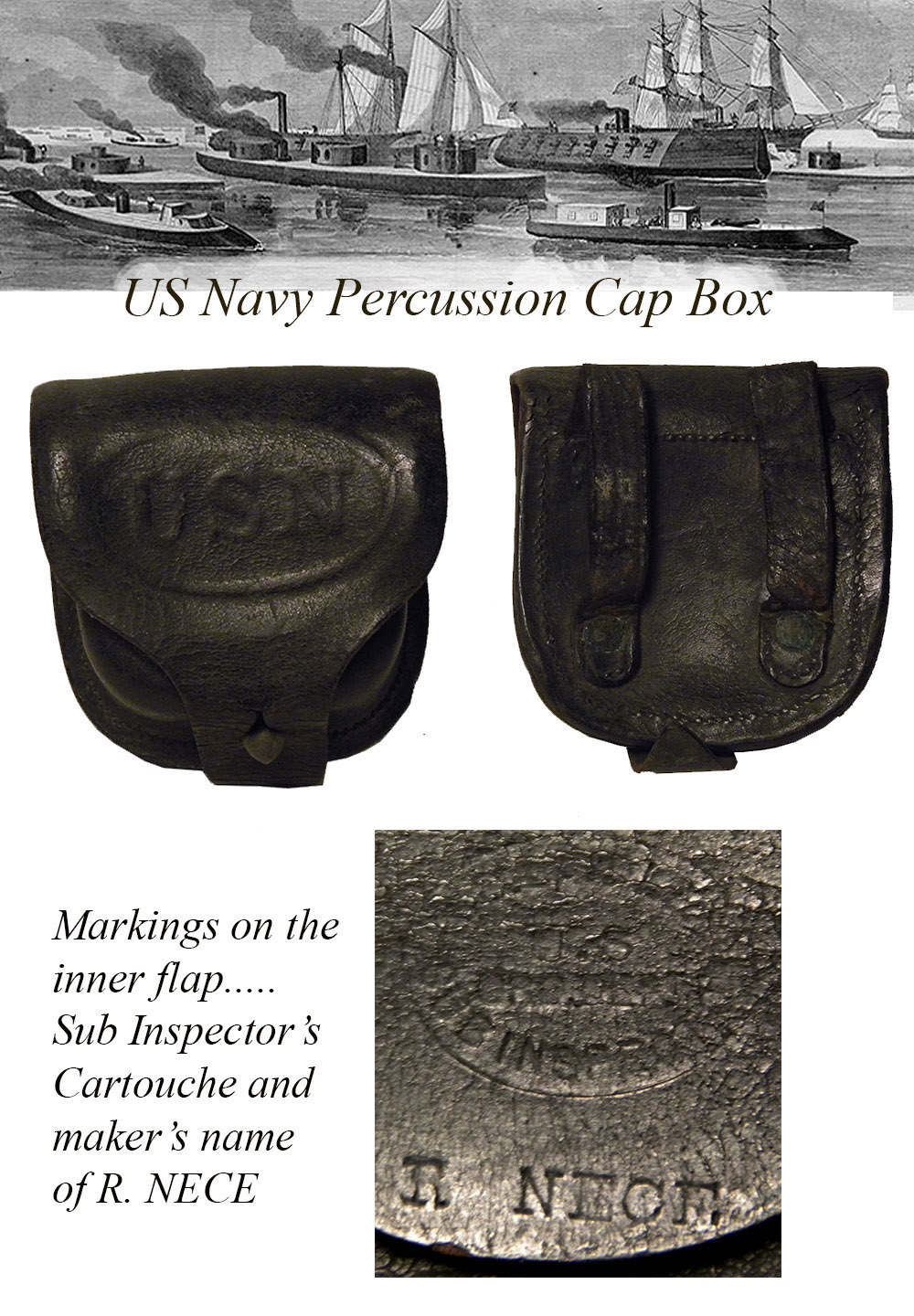
15-09-32 … US Navy Percussion Cap Box …
Identical to the army cap boxes except for the highly visual USN embossing on the front flap. About a hundred times rarer than army versions. Overall fine to excellent condition. Nicely marked with sub-inspector’s cartouche and makers name of R. NECE a famed Philadelphia accoutrement maker
… $325.00
Click Here to E-mail Us!
Call us @ 419-842-1863
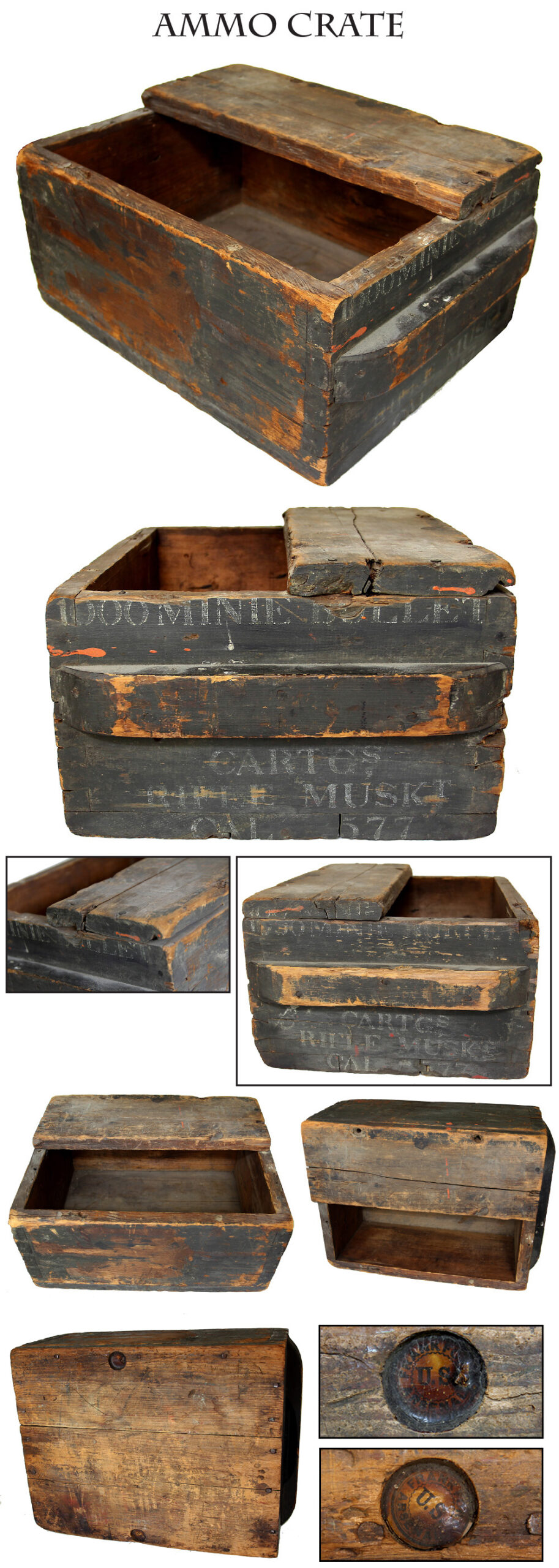
15-09-33 … Frankford Arsenal Crate for Rifle Musket .577 Minie Cartridges …
Ammo crates are one of the toughest Civil War items to find- they were everywhere during the war, but used up and burned for cooking. Rare to find in soldier’s effects. Here is an extremely scarce example for the Enfield cartridges … grayish/olive drab painted body… stenciled in white on each end: “1,000 MINIE BULLET / CARTG’s/ RIFLE MUSKt/ CAL. 577” The wood handles are in place and half the lid is still there, showing the top line of stenciling was done twice on one end. The holes for the heavy duty screws securing the lid are still there and about half the lid was kept and nailed back into place to use it for storage. The bottom of the crate is plain, without paint and still shows two Frankford Arsenal seals in recessed holes. The .577 caliber designation might indicate its intended use for Enfields, but in fact some ordnance letters of the time make clear it was a caliber designation for rounds intended for both .577 Enfields and .58 Springfield and Springfield contract rifle muskets. A few scattered paint drippings and wear to the top and some to the sides, but lots of original paint and very legible stenciling. A great display piece, and the first .577 crate I have owned
… $1,295.00 – SOLD
Click Here to E-mail Us!
Call us @ 419-842-1863
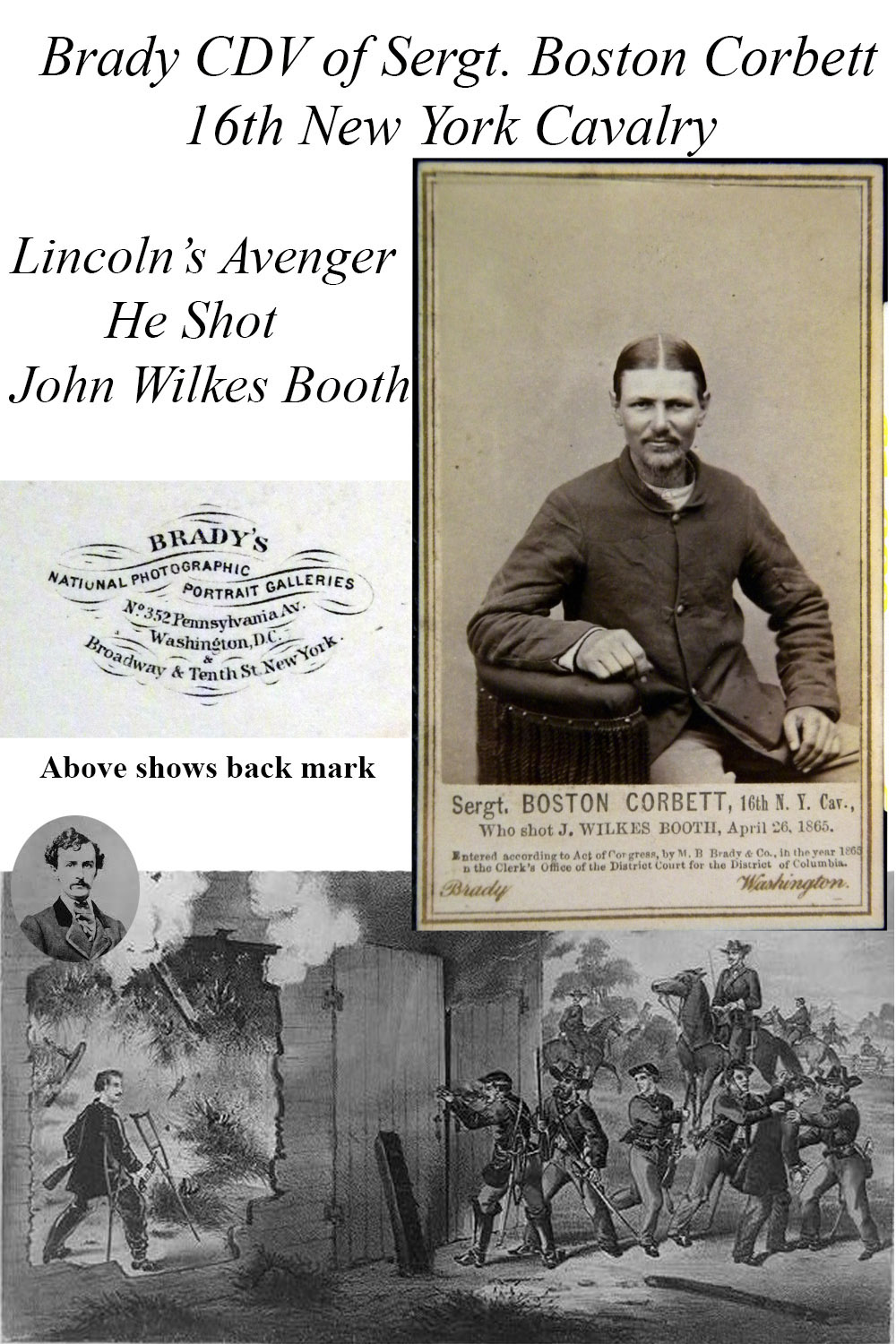
15-09-34 … From Life Albumen CDV Photograph by Matthew Brady of Boston Corbett …
the man who shot John Wilkes Booth. Corbett is dressed in his fatigue uniform consisting of a standard enlisted 4-button fatigue blouse with sergeant’s chevrons on each sleeve. Outstanding clarity, contrast, and condition. Bears Brady’s Washington, D.C. imprint on mount front and back. Bottom front bears full historical printed data. Corbett personally shot John Wilkes Booth to death at Garrett’s tobacco barn in Virginia … gaining himself some big time, though short lived, fame. Thomas “Boston” Corbett (est. 1832-1894) was born in London and immigrated to the U.S. with his family, where he found work as a hatter in New York City. After the war he reportedly castrated himself based on a skewed interpretation of Biblical instruction regarding lust. Some have speculated that the mercury exposure from his hatter’s profession caused his later mental problems. The phrase “mad as a hatter” does indeed have basis in fact. A very significant piece of Civil War photo history, and also very rare
… $595.00 – SOLD
Click Here to E-mail Us!
Call us @ 419-842-1863
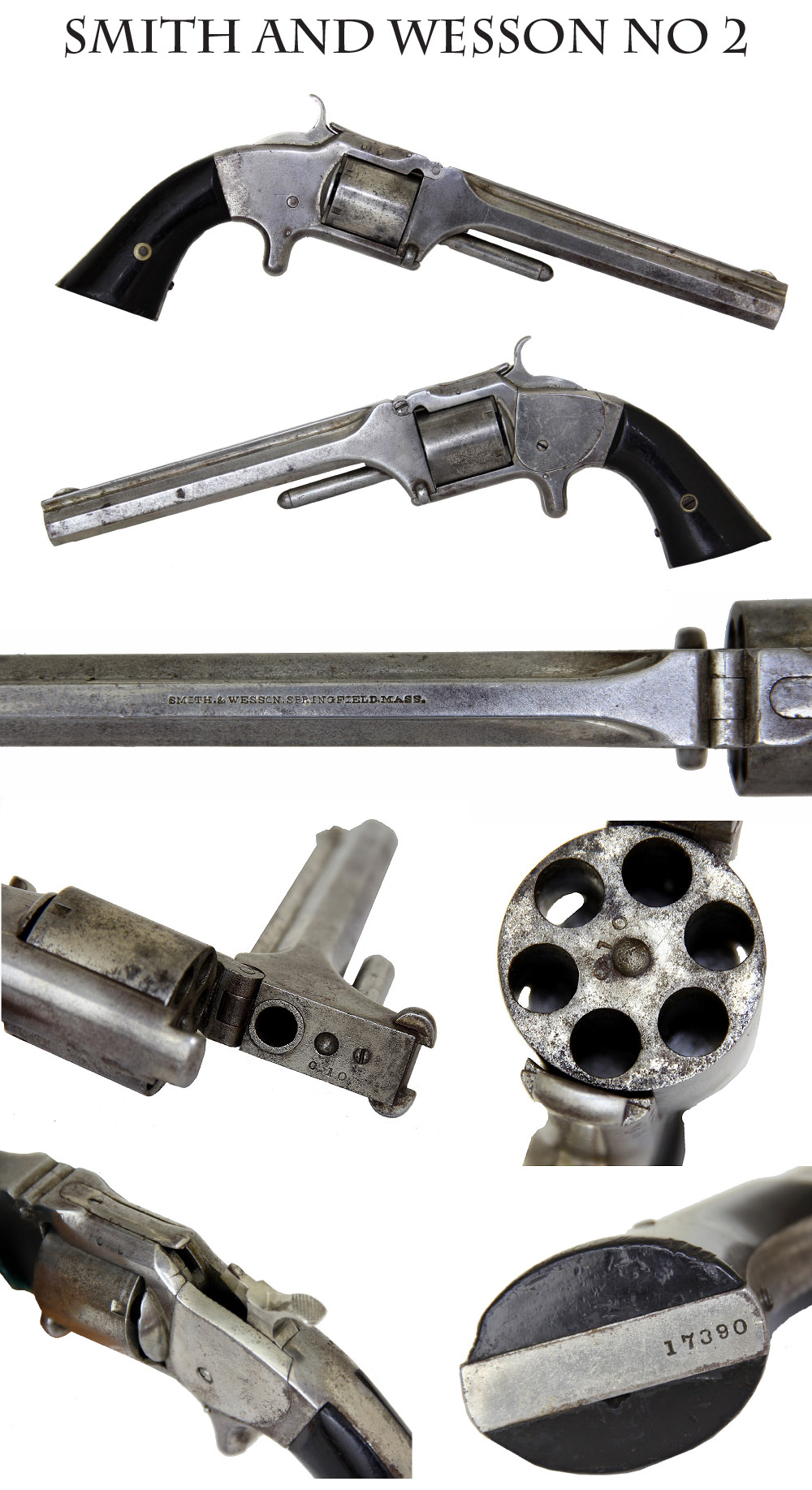
15-09-35 … Smith & Wesson No.2 Army Revolver …
Very Good example of the popular 32 caliber rimfire six-inch, six shot pistol with a serial number of 17,390 indicating a good early-war production date. Very popular because of the weather-proof self-contained cartridges. The grips are excellent. The metal shows a goodly amount of nickel finish, in protected areas. The balance of the steel was polished by a previous owner, I assume to brighten it to match the remaining nickle. Custer owned a pair of these and they were popular with western travelers, gamblers and the like. Even Wild Bill Hickock kept one as a back-up piece. Overall VG. 100% original and complete. Functions fine but you need to point the muzzle toward the ground when cocking to engage the “hand” which rotates the cylinder. A nice example at a friendly price. eej … sn17390 … eej-ahy
… $675.00
Click Here to E-mail Us!
Call us @ 419-842-1863

15-09-37 … 1859 McClellan Pattern Cavalry Saddle Bags …
Regulation issue cavalry saddlebags for the standard US cavalry enlistedman’s saddle of the Civil War, the 1859 McClellan. Both bags and covers in good shape. A very scarce piece of Civil War equipment. The covers are slightly stiff. Both latch tabs and buckles are in place. Interestingly this set was made without the bottom tie-down straps. These straps are usually found removed by the trooper (see other set of bags below for further data) but this set was manufactured without them. Perhaps a mid war directive that I am unaware of called for the elimination of the straps. Interior pockets good. As usual the leather laces on the inside are gone but can be replaced with any old rawhide boot laces. One small repair to the edge of the cross strap at the hole where one of the locking straps for a bracket passes over it. The cross strap itself is solid and in good condition, which is rare since people often try to fold these flat and break the straps across the middle. A very good displayable set and a key piece of horse gear and one that has always been scarce … noco
… $1,250.00
Click Here to E-mail Us!
Call us @ 419-842-1863
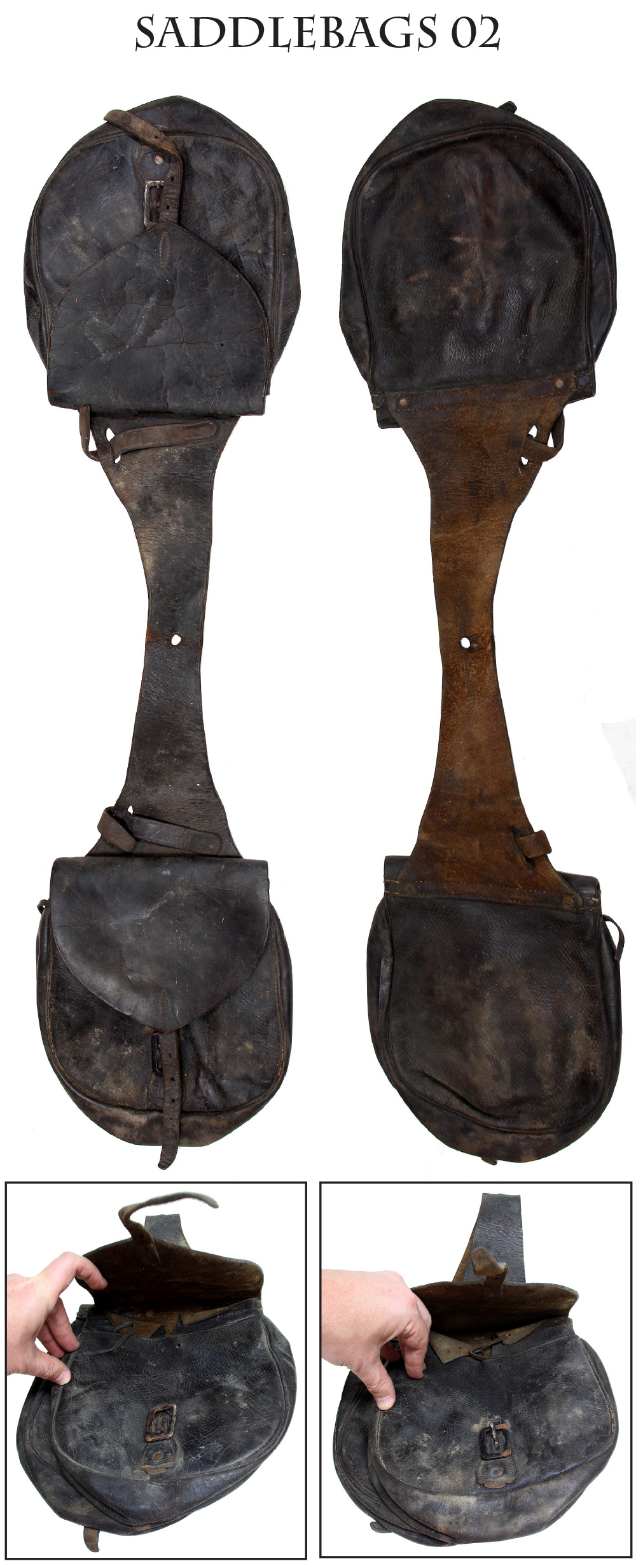
15-09-38 … A Second Set of 1859 McClellan Saddle Bags …
Another set of the regulation saddle bags for the US cavalry 1859 McClellan saddle. Like the first set offered on this list, the bags have an intact cross strap, which is the piece most liable to be damaged, both latch tabs and both buckles, and intact locking straps that pass through raised brackets on the saddle and hold the bags in place after they are draped over the saddlebag stud at rear of the saddle. Whereas the above bags were manufactured without tie-down straps this sethas had the tie-down straps removed. This is usually the case with saddle bags found in estates. Some stiffness and cracking to the surface of the covers, but the bags themselves are supple and the covers are not rigid or fragile. A key piece of horse gear and a good part of any cavalry display or collection
… $975.00
Click Here to E-mail Us!
Call us @ 419-842-1863
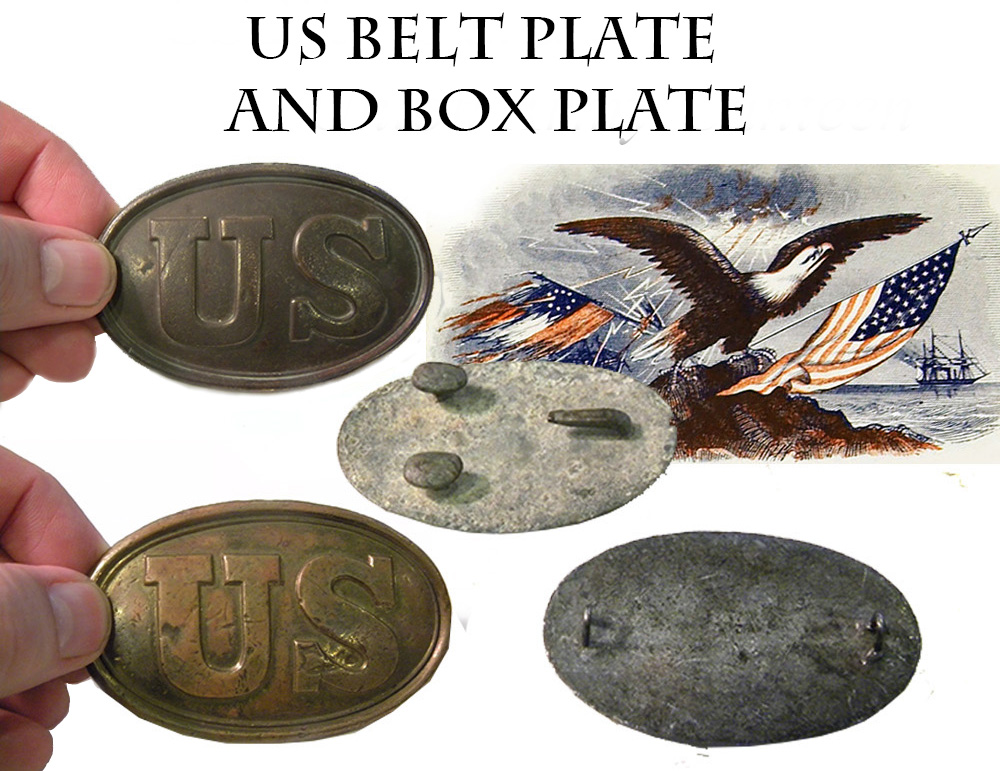
15-09-39 … Perfect Condition Dug “STUD-BACK” US Oval Waist Belt Plate: …
Absolutely perfect early war US infantry buckle with the oval studs and heavy prong on the back. This one if from the Steve Sullivan collection but unfortunately there was no note where it was found. Super example.
$325.00
15-09-40 … Non-Dug US Cartridge Box Plate:
Another top notch plate. This one excellent, just as it was brought home by Billy Yank. Both loops solid.
$199.00
Click Here to E-mail Us!
Call us @ 419-842-1863
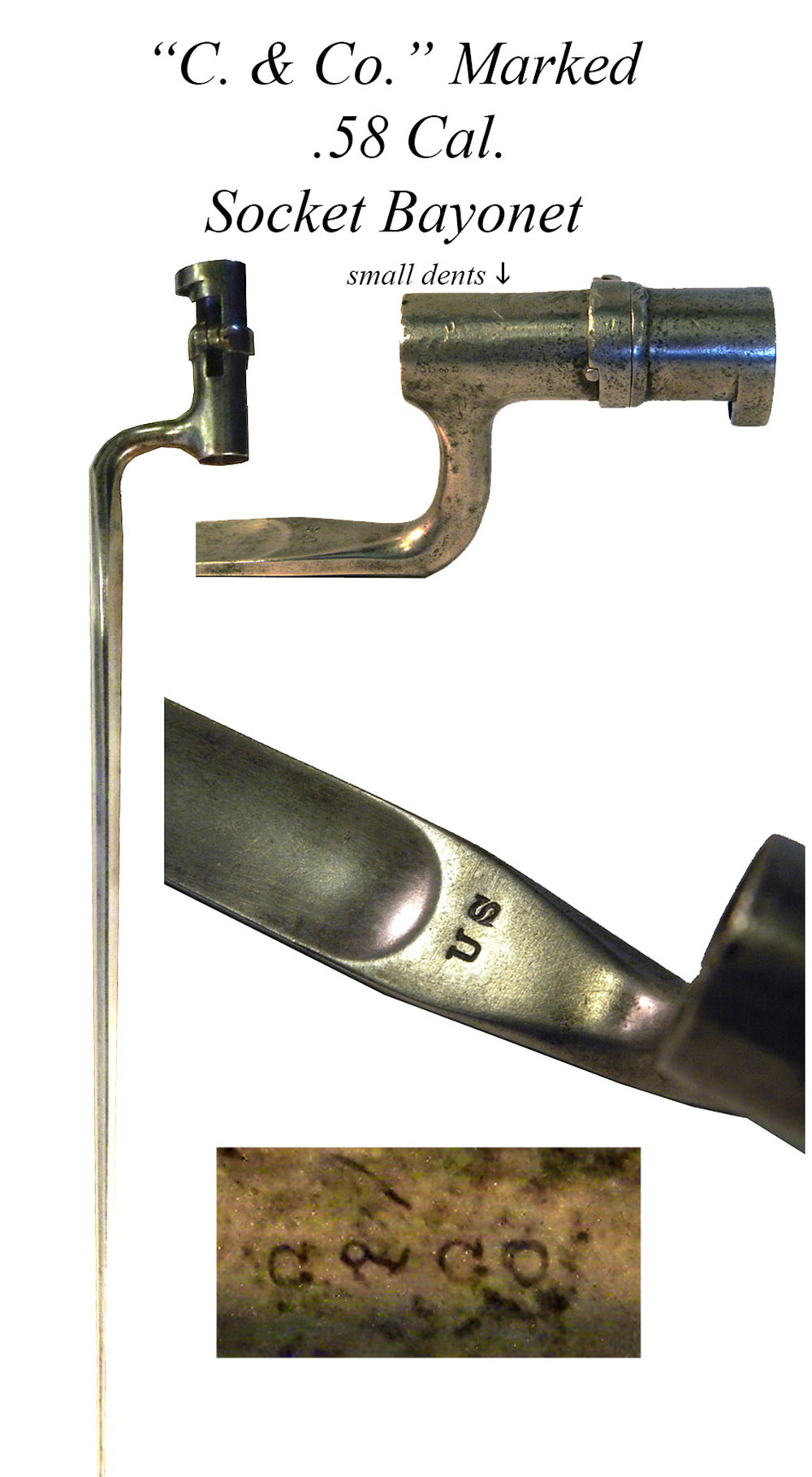
15-09-41 … Collins and Company Marked Socket Bayonet …
Regulation 1861 .58 caliber socket bayonet in overall VG++ condition. Overall smooth steel with some shine. Sharp US mark on the ricasso. Socket marked in small lettering “C & Co.” which shows manufacture by Collins and Company of Hartford. Also stamped with inspector’s initial “H” at the mortise. Forward section of the socket has three OLD shallow bangs where it appears the soldier used his bayonet to tap a nail into his winter quarters … OR … maybe some early 1900s era handyman at Bannerman’s was too lazy to hunt up a tack hammer and there were hundreds of these bayonets laying around which would serve his purpose. In any event the little dents are minor, not affecting the fit, and are mentioned only for the sake of accuracy. If I am not mistaken Colt’s Special Model 1861 muskets were issued with these C & Co. blades. Very good example, and on the scarce side. Would be a good match for a musket in the $1800 to $2500 value range
… $175.00
Click Here to E-mail Us!
Call us @ 419-842-1863

15-09-42 … Large Bore Socket Bayonet …
Very similar in style to the Fayetteville socket bayonet but enough different that I believe it to be for a European import musket. 21.25 inches overall. 18.25 blade length. 3 inch socket length, .82 inner diameter of socket. Brown crusty patina overall. Locking ring rotates freely. Missing the little ring stop on the socket which would be simple to replace. (Just bang a nail into the hole, finish it off, and rust it.)
… $100.00
Click Here to E-mail Us!
Call us @ 419-842-1863
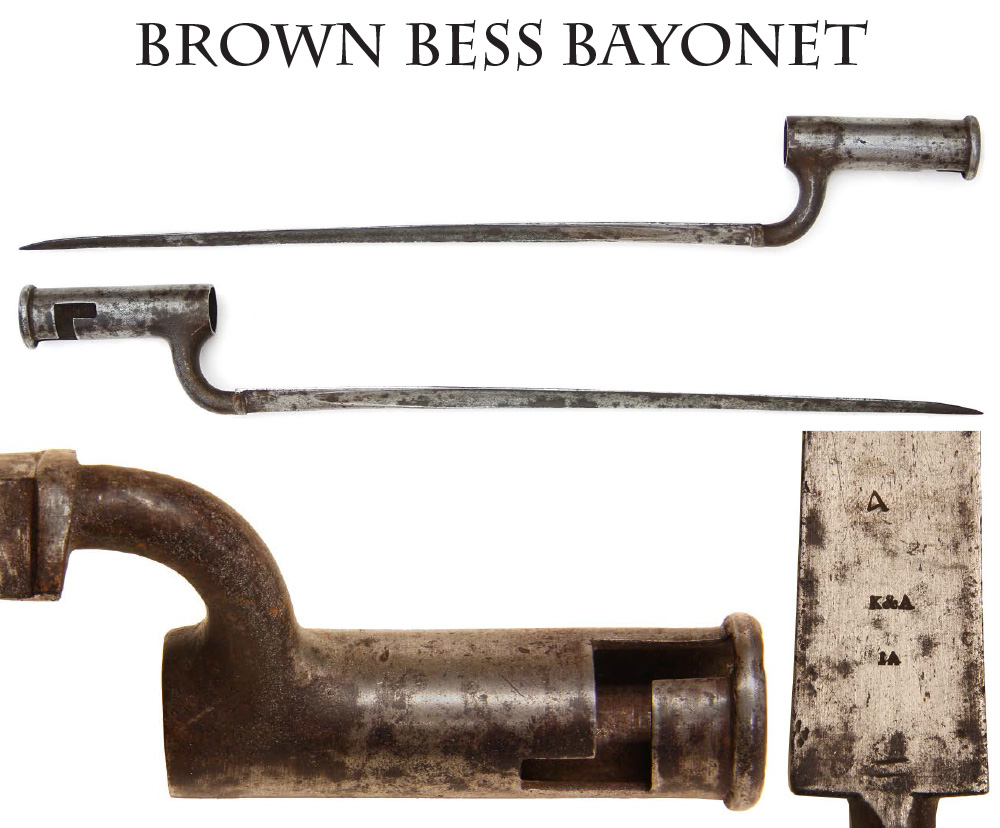
15-09-43 …
By Discipline and Bayonets!
…
British late 18th – early 19th century Brown Bess Bayonet. Stats 18-5/8” overall. 14-3/8” blade. 3-9/16” socket. .848” inner diameter. Redcoats charging with fixed bayonets scattered many an opposing force. Our own militia in the Revolution often suddenly remembered better things to do back home than stand and face an oncoming line fringed with blades like this. Nice condition, silvery gray overall mixed with some darker areas. Just very light salt and peppering on the shank. Markings include an inspector numeral “4” on the face, along with “K&A” (Ketland and Allport … Allport was dead by 1817). Also marked “1A.” K&A supplied several contracts. This blade I believe is for a third model Bess supplied on the commercial market- I don’t see a crown marking. There are quite a number of variants of this bayonet and it forms a collecting subgroup of its own.
This one is real nice with the early maker’s marks.
… $195.00
– SOLD
Click Here to E-mail Us!
Call us @ 419-842-1863
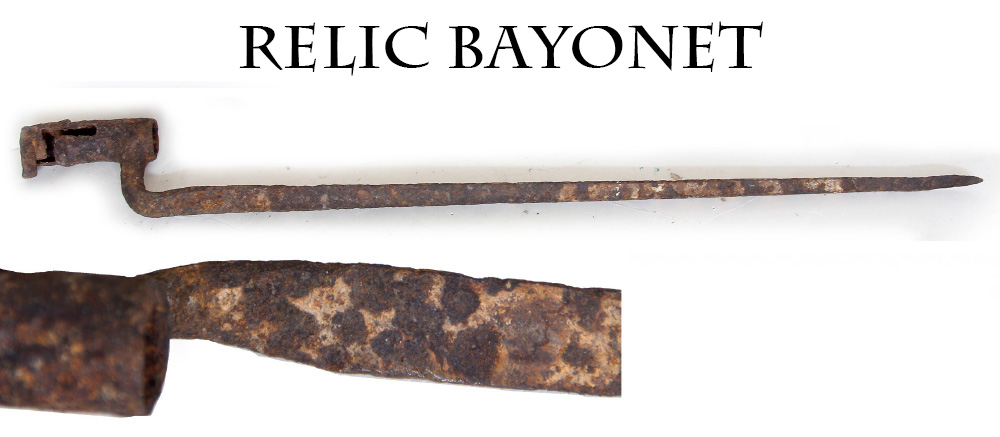
15-09-44 … Relic 45/70 Trapdoor Bayonet …
A dug-up (out of the ground) Springfield bayonet for the 1873 trapdoor. Typical rusty, crusty, dug-relic condition. Lacks locking ring. No idea where it was found. I got it in a big collection of eclectic
stuff
when an old Toledo collector died and his brother sold me the whole kit and kaboodle. Great Indian War relic. Perfect for Wild West display … and cheap
… $25.00
Click Here to E-mail Us!
Call us @ 419-842-1863

15-09-45 … Friction Primer Tin [Tin not for sale] and Percussion Caps …
I just purchased this neat old relic and am offering the percussion caps inside the tin in this offering. This very scarce tin came just as you see it, filled with percussion caps for muskets. The tin itself is the arsenal tin used to hold artillery friction primers. These are darned hard to find! I can only think of one instance where I found one still in a primer pouch! The tin has a hinged cover with small latch and embossed top reading: 100 FRICTION PRIMERS in an arc over an ordnance insignia, and FRANKFORD ARSENAL on either side. I don t know who put the percussion caps in the tin, it was certainly a handy storage idea, but since they do not belong together, I am splitting up the lot.
In each package of ten cartridges the soldier got 12 caps. While the supply lasts I will sell the percussion caps …
One Dozen … … … $15
Two Dozen … … … $25
Five dozen … … … $50
Click Here to E-mail Us!
Call us @ 419-842-1863
Layaways are Welcome
Need to split your order into multiple payments? No problem! A simple 20% earnest money deposit will hold your item for you.-acf
You can then pay it off in easy installments that fit your budget.
Read Terms Here
Items to Sell? Contact Us
I am always interested in buying ANYTHING from the American Civil War… Guns, Swords, Civil War Muskets, Knives, Uniforms, Flags, Medals, Badges, Diaries, Letters, Autographs, Buttons, photographs, tintypes, daguerreotypes, Insignia, Camp Items, Battlefield Relics, canteens, Drums, Etc… Call 419-842-1863 and ask for Dave Taylor.

